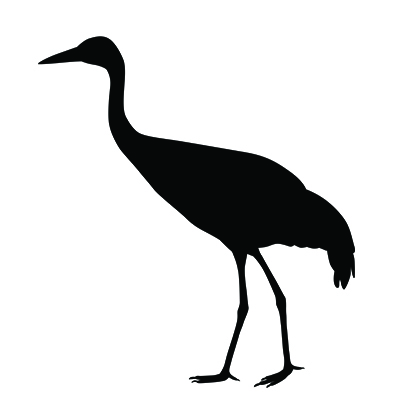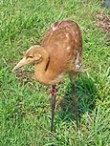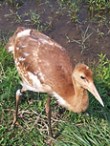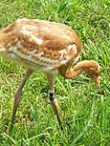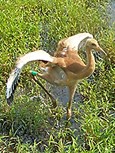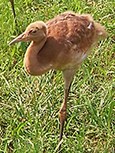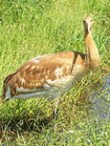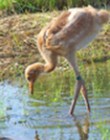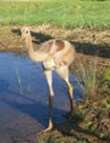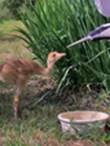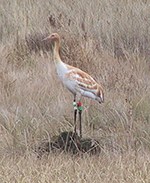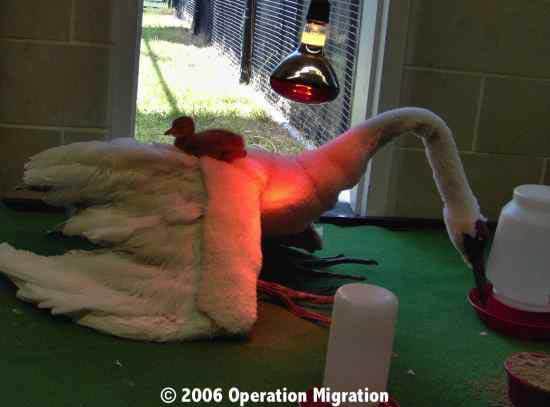Two release methods were used in 2006: Ultralight-guided (Group One) and Direct Autumn Release (Group Two). Group Three includes the first successfully fledged wild hatched Whooping Crane in the Eastern Migratory Population!
All Whooping crane released in 2006 under the aircraft-guided method learned a migration route by following Operation Migration’s aircraft from Necedah National Wildlife Refuge in Juneau County, Wisconsin, to Chassahowitzka National Wildlife Refuge in Citrus County, Florida.
The 1200-mile southward migration began October 5, 2006, and ended 78 days later on January 12, 2007.
*Note: Tragically, all but one of the “Class of 2006” ultralight-guided cranes were killed on February 2, 2007, when a storm hit their wintering grounds in Florida. The single remaining crane, #15-06, managed to escape the enclosure but died in the spring.
Group One: Ultralight-guided Whooping Cranes








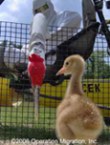
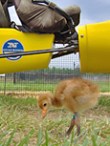
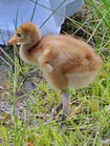
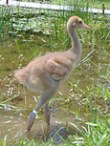
Crane #1-06
Sex: Male
Hatch Date: May 5, 2006
Personality and Characteristics: Migration Training – He was going outside for walks with the other four oldest chicks at 5 days of age. They get along very well. He came to Wisconsin for flight school on June 27 in cohort one, the eight oldest chicks. By July 20, he was starting to fly. He immediately got airborne behind the trike and flew the entire distance of the runway!
By August 15 he was flying up to 10 minutes in large circles over a big pool at the refuge.
Chicks #1-06 and #2-06 are the oldest, and they seem to be what most older siblings should be: good role models for their other flockmates. “These two always seem to do what they need to and seldom get into any mischief, said Marie.
History
First Migration South: Chick #1-06 left Wisconsin for his first migration on October 5th, 2006. He flew the whole first leg of the journey and landed safely at Stopover #1!
Oct. 14: To entertain the birds, the team gave them some corn cobs. “After grabbing hold of one cob, something about it must have freaked out #1-06,” said Marie. “He dropped the cob, jumped back and ran away from it as it if it had bit him!”
Dec. 3: After flying well with the ultralight all this time, #1-06 dropped out today. He (and 2 other birds) had to be boxed and driven to the next stop at Gordon County, Georgia.
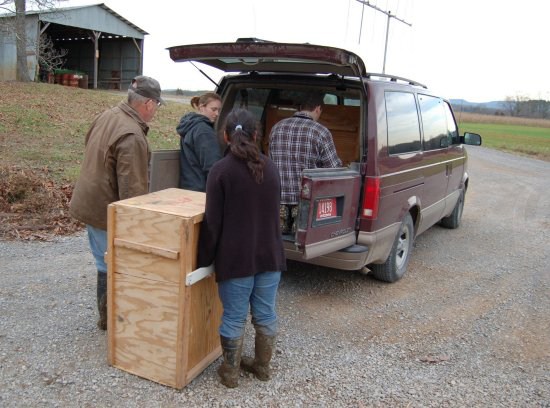
Photo Bev Paulan, Operation Migration
Jan. 12, Moving Day: #1-06 made it almost half way on the first moving day before he (with some others) had a rest stop, another try, and still landed short in Citrus County—still 10 miles from the Chass pen. They were too tired to try again, so they spent the night in a travel pen with others that had been crated and brought to the same site. The next morning in calm air and clear skies, #1-06 and the other 11 chicks who hadn’t cooperated yesterday took off with Joe’s plane. Their final flight with the ultralight lasted 18 minutes. They landed at their final winter home at “Chass,” where six flockmates had arrived the day before. Migration complete!
Feb. 2, 2007: Crane #1-06 died when violent storms moved through central Florida during the night, killing all 17 chicks in the pen at Chass. Only #15-06 somehow managed to escape. Nineteen humans lost their lives the same night.
Click here to jump to the top of this page.
Crane #2-06
Sex: Female
Hatch Date: May 5, 2006
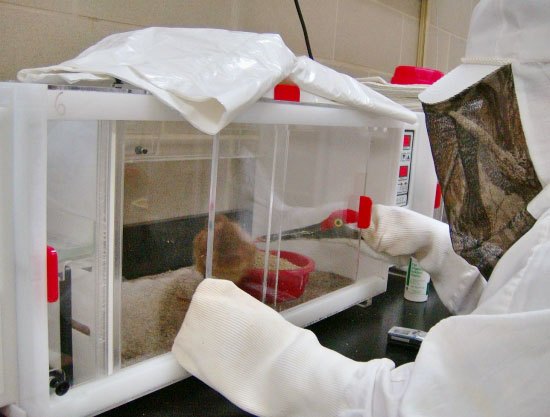
Laurie is using a puppet to show new chick #2-06 how to eat. The puppet looks like an adult whooping crane so the chick will know its species. The food bowl is red because chicks are attracted to red. Laurie wears a baggy white costume to hide her human form.
Personality and Characteristics: Migration Training – #2-06 was the very first chick hatched from an egg laid by wild parents in the Eastern flock! Everyone was thrilled to welcome her. Here’s a picture of her taking a nap:
This is chick #2-06 on May 10, 2006. She hatched on May 6. She likes to stay warm so she picked this place for a nap. She is under a warming light. She is lying on a pretend whooping crane because it makes her feel safe. Crane models and puppets, as well as real cranes nearby, help her to recognize whooping cranes as her species.
She had a sister (#3-06) who didn’t make it into the ultralight flock because she died at the age of 45 days.
When she was really little, she got scared when the ultralight engine started up. She was nervous in the circle pen when she was supposed to walk in a big circle, following the plane as it drove slowly around the outside of the pen. But all her terror vanished if she spied something good to eat. She has always liked the water and jumps right in to bathe and forage. She came to Wisconsin for flight school on June 27, 2006 in cohort one, the 8 oldest chicks.
Hopping and flopping behind the ultralight plane during training on July 18, #2-06 got airborne and flew about 15 feet off the ground! The pilot said, “She looked rather proud of herself after she managed to make a less-than-spectacular landing.” On July 20, #2-06 immediately got airborne behind the trike and flew the entire length of the runway!
By August 15 she was flying up to 10 minutes in large circles over a big pool at the refuge. Pilot Chris says, “We do large looping circuits back to the pen site so birds can land if they are getting tired. After landing, we have been finding that the birds recover very quickly and are ready for more.”
She’s not aggressive any more, like she was as a tiny chick. But she does have a mind of her own. On September 18 she didn’t want to follow the ultralight when her cohort was finally being led over to join all the rest of the chicks. She and #6-06 were left behind to think things over by themselves. Two days later they were happy to join their flockmates, and now the whole group is together at one pen site.
History
First Migration South: Chick #2-06 left Wisconsin for her first migration on October 5th, 2006. She was one of the 17 birds who flew the whole first leg of the journey and landed safely at at Stopover One! Chicks #1-06 and #2-06 are the oldest, and they seem to be what most older siblings should be: good role models for their other flockmates. “These two always seem to do what they need to and seldom get into any mischief, said Marie.
Oct 14: To entertain the birds when they were stuck 4 days at Stopover #2, the team gave them some corn cobs. See #2-06 in the photo!
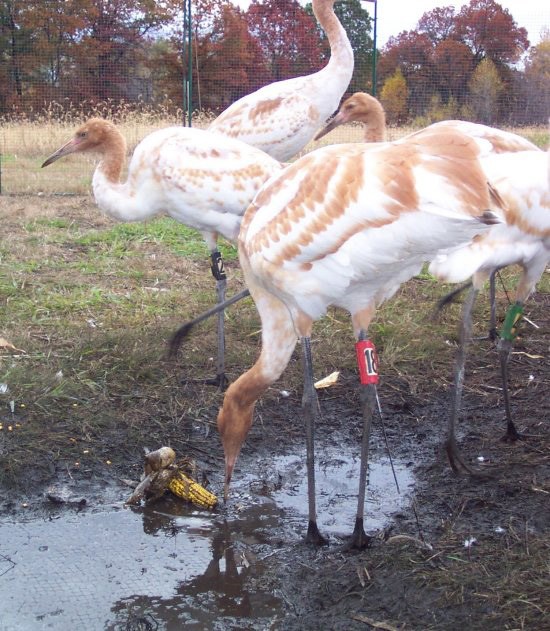
The team gave the chicks a few corn cobs to play with. See them? Marie tells about it: “We put the partially shucked cobs on the ground and watched the birds approach them, cautiously at first. In a matter of seconds the cobs were being tossed and picked over, corn sent flying from strong pecks. (You wouldn’t believe how strong these chicks can peck until one pecks on your boot. It isn’t long before a bruise appears.)
Oct. 15: Near the end of today’s flight, chick #2-06 broke off and the pilot went after her. She landed about a mile short of the finish line at Stopover #3. The pilot set down nearby and tried to get her back up flying. But she was having NO part of it. They let her rest 20 minutes before trying again. She still wasn’t interested. The ground crew brought a crate to take her the rest of the way.
Oct. 23: After 7 days of being penned, #2-06 wasn’t at the top of her game. She had trouble with a ridge, landed with Joe to rest, and then dropped out again after the second take off. The owner of the corn field she was in spotted her when his dog’s barking got his attention. Crane #2-06 obviously got startled by the barking dog and people who looked like, well – people, and she hid in the cornfield. Marie and Bev walked into the field and started a search pattern at one end, while Sara and Laurie walked along the edge using a tracking device and vocalizer to send out brood calls. Eventually we spotted #2-06 at the far end of the field. She was struggling her way out and moving toward us in a hurry. It was a long walk to the crate but she followed us very closely and we were relieved that her adventure was over. She was crated and driven to the next stopover.
Jan. 12, Moving Day: #2-06 made it only part way on the first moving day (Jan. 11). She dropped out with #8-06 and landed in a field before reaching Chass. Brooke searched on foot (in his costume) and found the birds. He led them to a small clearing behind some trees to keep them safely hidden. Soon a dirt biker zoomed through the grass less than 100 yards away. Brooke and two scared birds hunkered down to avoid detection. Four hours later, Brooke and the birds were located. They crated the birds and drove them to join the other tired dropouts now in a travel pen in Citrus County—still 10 miles from the Chass pen. The next morning in calm air and clear skies, #2-06 and the other 11 chicks who hadn’t cooperated yesterday took off with Joe’s plane. Their final flight with the ultralight lasted 18 charming minutes. They landed at their final winter home at “Chass,” where six flockmates had arrived the day before. Migration complete!
Feb. 2, 2007: Crane #2-06 died when violent storms moved through central Florida during the night, killing all 17 chicks in the pen at Chass. Only #15-06 somehow managed to escape. Nineteen humans lost their lives the same night.
Click here to jump to the top of this page.
Crane #4-06
Sex: Female
Hatch Date: May 8, 2006
Personality and Characteristics: Migration Training – She started out afraid of everything! She came to Wisconsin for flight school on June 27 in cohort one, the 8 oldest chicks. By August the chicks were showing their independence. For example, it sometimes took longer to herd the birds back into their pen than the day’s actual training. Sometimes the adults #1-01 and #1-02 were right there in the mix, stirring up the chicks. That happened on Aug. 7. After much grape tossing and then some herding, all the chicks were tucked away. But #4-06 was the straggler. She didn’t want to go back in the pen!
By August 15 she was flying up to 10 minutes in large circles over a big pool at the refuge.
History
First Migration South:
Oct. 5, 2006: Chick #4-06 left Wisconsin for her first migration on October 5th, 2006. After the departure from Necedah, #4-06 flew back to the pen before reuniting with the other chicks by following her own private aircraft! After the pilots landed with the other 17 birds, they turned around to look for #4-06; Joe found her on the runway in front of the chicks’ pen back home on the refuge. It took several tries to get her to follow the ultralight plane. She kept breaking off, so the good old Swamp Monster appeared.
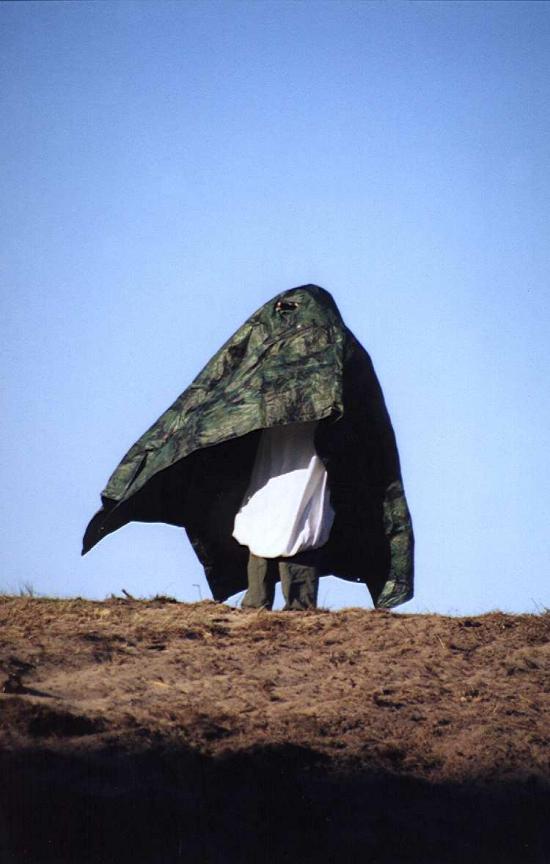
You can see that Swamp Monster is really a pilot or crane caretaker under a big camouflage canvas. The swamp monster shakes the canvas to make loud noises. The birds have never seen or heard anything like it, so they get scared. They take off running or flying to get away!
It worked! Chick #4-06 flew alongside Joe to join her classmates in the travel pen at Stopover #1. It was a new migration record: all chicks flew to the first stop.
Oct. 10: After 4 no-fly days, #4-06 (and #6-06) decided that they would hang out inside the pen while the rest rushed out to greet the waiting trike. When Joe’s trike and 16 birds took off, #4-06 (and# 6-06) were still back on the ground at the pen. Brooke moved in to pick these two up. They flew the whole 18 miles with Brooke’s plane for a good trip to Stopover #2.
Oct. 12: The birds have been grounded at Stopover 2 by windy, cold weather. How cold? The water buckets and footbaths in the birds’ pen is frozen over with a half inch of ice. Marie and Charlie used their puppets to break through the ice. The chicks decided they would peck at the newly broken-up ice, too. Standing on one foot, (because its too darn cold to stand on both) the chicks clustered around the buckets pecking and picking up the ice. After chipping her ice chunk down to a more reasonable sized ice cube,#4-06 swallowed it whole!
Oct. 23: After 7 days of being penned, #4-06 had a little trouble climbing to cross a ridge soon after takeoff. She landed with Joe to rest, and then did better after a second take off, flying on Joe’s wingtip. With only two birds, Joe climbed to 2,500 feet and they made it to the next stopover. Read more.
Oct. 31: On this no-fly day, Marie went to the pen to check the birds: “Most of the birds were peacefully eating and drinking together and peeping contentedly. That is, until #13-06 picked up a golf ball sized seedpod that #4-06 wanted. #4-06 went after it as #13-06 ran toward a water bucket to clean off her find. Then #6-06 ran in to grab the seed, but #13-06 gulped it down too quickly. #6-06, obviously disgruntled that she didn’t get any, gave #13-06 a peck on the back. That seemed to restore the peace, and by the time we left the pen the three birds were foraging side-by-side.”
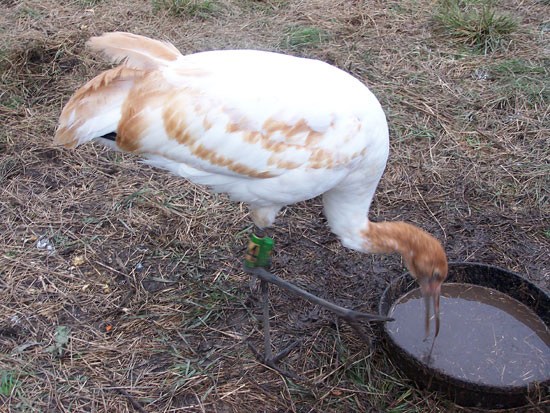
December 2: She made it over the Cumberland Ridge! But she wasn’t a willing flyer after that tough day. On the December 3 flight she was one of the three birds that were crated and driven from Hiwassee Refuge to Gordon County, Georgia.
January 12, 2007: Moving day! Chick #4-06 (along with #6-06 and #23-06) refused to follow the ultralight planes today when the pilots tried to move the 18 chicks from the layover site to “Chass.” #4-06 was boxed and taken to a travel pen in Citrus County for overnight with other chicks that quit flying before they reached Chass. The next day was better and #4-06 flew with Joe and 11 other chicks the last 5 miles to their final winter pen. Home!
Feb. 2, 2007: Crane#4-06 died when violent storms moved through central Florida during the night, killing all 17 chicks in the pen at Chass. Only #15-06 somehow managed to escape. Nineteen humans lost their lives in Florida the same night.
Click here to jump to the top of this page.
Crane #5-06
Sex: Female
Hatch Date: May 9, 2006
Personality and Characteristics: Migration Training – She was going outside for walks with the other oldest chicks at 5 days of age. They get along very well. She came to Wisconsin for flight school on June 27 in cohort one, the 8 oldest chicks. During flight training on July 18, most of the birds were able to fly for a short distance in ground effect, and #5-06 glided under the ultralight’s wing at least 50 feet before losing momentum and returning to earth!
By August 15 she was flying up to 10 minutes in large circles over a big pool at the refuge.
History
First Migration South: Chick #5-06 left Wisconsin for her first migration on October 5th, 2006. She flew the whole first leg of the journey and landed safely at Stopover #1!
Oct. 23: Cranes scattered everywhere on today’s trip after several days of no flying. While trackers were getting the first 4 chicks who landed in a nearby field back to the pen, the ‘location and number unknown’ chick magically flew back to the pen by herself. It was #5-06! “What a smart girl she is!” exclaimed Marie. Indeed, her self-homing behavior really helped the tracking team; it allowed them to go in search of another missing crane on that crazy day.
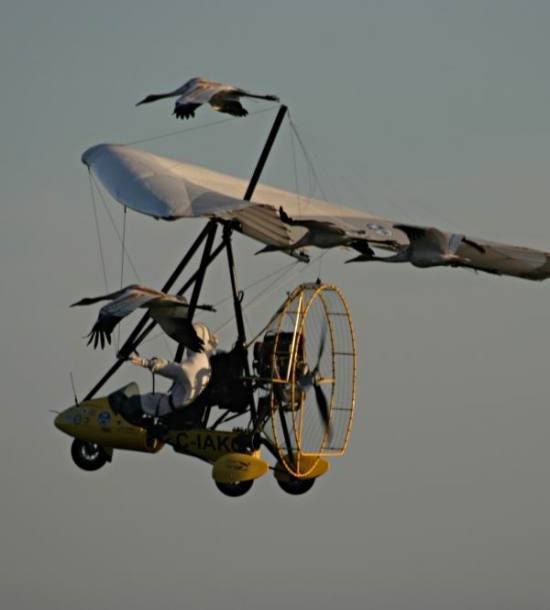
Oct. 24: She did great once again! This migration leg from the 4th to the 5th Stopover was the best so far! No birds dropped out, or returned, or got crated.
Dec. 16: On today’s flight across the border to Florida, #5-06 seemed to have more energy than the rest. This makes it harder for the other birds, so the pilots let her lead for a while. “She would look back with a tilt to her head every once in a while, checking to see where we were going,” said Richard. “If we turned left, she would turn left; we’d turn right and right she would go. So while she was in front, she really wasn’t leading. This tired her after 20 minutes or so, and back she would come and fly off the wing. Later it would start all over again.” After more than two hours of flight, they finally landed in Hamilton County, Florida!
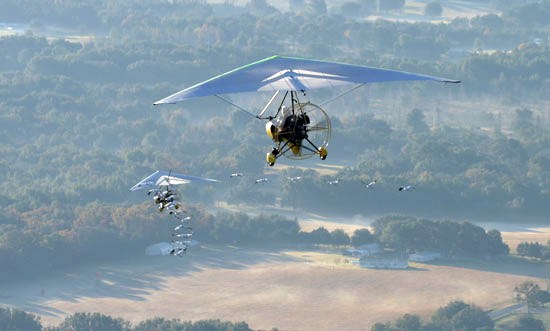
January 12, 2007: Moving day! Chick #5-06 followed the ultralight planes Jan. 11 when the pilots tried to move the 18 chicks from the layover site to “Chass.” He was one of only 6 birds that cooperated! Hooray! Migration complete.
Feb. 2, 2007: Crane #5-06 died when violent storms moved through central Florida during the night, killing all 17 chicks in the pen at Chass. Only #15-06 somehow managed to escape. Nineteen humans lost their lives in Florida the same night.
Click here to jump to the top of this page.
Crane #6-06
Sex: Male
Hatch Date: May 11, 2006
Personality and Characteristics: Migration Training – He was a bad bully as a tiny chick. He didn’t follow the costume on walks but he did do well with training. He came to Wisconsin for flight school on June 27, 2006 in cohort one, the 8 oldest chicks. By July 20, he was one of the first ones starting to fly. He immediately got airborne behind the trike and flew the entire length of the runway! By August 15 he was flying up to 10 minutes in large circles over a big pool at the refuge and always seems ready for more. By the end of August, all 8 of the oldest birds were flying together like a well-trained squadron. They could fly for 30 minutes or more. They didn’t even get scared when they flew behind the ultralight over a busy highway below.
On September 18 he didn’t want to follow the ultralight when his cohort was finally being led over to join all the rest of the chicks. He and #2-06 were left behind to think things over by themselves. Two days later they were happy to join their flockmates, and now the whole group is together at one pen site.
History
First Migration South: Read day-by-day news about the flock’s migration to see what happens.
Oct. 5, 2006: Chick #6-06 left home at the Wisconsin refuge for his first migration. He flew the whole first leg of the journey with ultralight airplane leaders, and landed safely at Stopover #1!
Oct. 10: After 4 no-fly days, #6-06 (and #4-06) decided that they would hang out inside the pen while all the other birds rushed out to meet the waiting trike. When Joe’s trike and 16 birds took off, #6-06 (and #4-06) were still back on the ground at the pen! Brooke moved in to pick these two up. They flew the whole 18 miles with Brooke’s plane. It was a good day!
October 14: After being in the pen for 4 bad weather days, Marie thought the birds were antsy to leave. “Tempers are flaring, and this morning #6-06 and #12-06 were doing the ‘I’m bigger than you’ thing. Most times stretching their necks out is enough of a threat and one of the birds will back down and wander off. This time both started flapping and jumping at each other until the other birds formed a ‘fight ring’ around them. Just as I walked over to them, #6-06 decided he had had enough and walked away from #12-06.” Luckily, the next day the birds got to fly!
Oct. 15: All 18 birds took off behind Brooke’s plane today, but the ground crew always stays put for at least 10 minutes to make sure that none of the birds turn and head back to the pen. Today #6-06 and #18-06 both circled back. Thanks to the Swamp Monster (aka Bev) to keep them from landing, the pilot was able to pick up the two that returned. But they circled back AGAIN. Finally, Charlie caught them and drove them all the way to Stopover #3 in special boxes in the van.
Oct. 23: News about #6-06, #8-06, #15-06 and #18-06 landing in the field came through the radio shortly after departure from Stopover #3. With the exact location of these chicks provided by our top cover pilots, Don and Paula, Bev and Sara went to them right away to secure their safety. They were crated and driven to Stopover #4.
Oct. 26: When Bev and Marie checked the birds in the pen on this no-fly day, #6-06 was very grumpy and pecked hard at the costume. Then #6-06 moved up to #7-06 and pecked him once. Was #6-06 telling his buddy to “chill out” and back off?
Oct. 31: On this no-fly day, Marie went to the pen to check the birds: “Most of the birds were peacefully eating and drinking together and peeping contentedly. That is, until #13-06 picked up a golf ball sized seedpod that #4-06 wanted. #4-06 went after it as #13-06 ran toward a water bucket to clean off her find. Then #6-06 ran in to grab the seed, but #13-06 gulped it down too quickly. #6-06, obviously disgruntled that she didn’t get any, gave #13-06 a peck on the back. That seemed to restore the peace, and by the time we left the pen the three birds were foraging side-by-side.”
Nov. 23: “We often find a layer of ice in the water bucket during the morning check,” reports Laurie. This morning, we found pieces of ice on the ground next to the water buckets. It looked like somebody picked out the ice and piled the pieces up on the ground. After we dumped the water with ice into the footbath, #6-06 went right up to it and started to play with the ice. Now we knew who might have been involved in the ice removal activity.”
January 12, 2007: Moving day! Chick #6-06 (along with #4-06 and #23-06) refused to follow the ultralight planes today when the pilots tried to move the 18 chicks from the layover site to “Chass.” #6-06 was boxed and taken to a travel pen in Citrus County for overnight with other chicks that quit flying before they reached Chass. The next day was better and #6-06 flew with Joe and 11 other chicks the last 5 miles to their final winter pen. Home!
Feb. 2, 2007: Crane #6-06 died when violent storms moved through central Florida during the night, killing all 17 chicks in the pen at Chass. Only #15-06 somehow managed to escape. Nineteen humans lost their lives in Florida the same night.
Click here to jump to the top of this page.
Sex: Female
Hatch Date: May 13, 2006
Personality and Characteristics: Migration Training – She came to Wisconsin for flight school on June 27 in cohort one, the 8 oldest chicks. After a string of very hot days, on July 18 she wasn’t in the mood for flight school. She was finally coaxed outside the pen after having missed 2 taxi runs up and down the runway. But she began to make progress in getting off the ground and following the trike. On Aug. 7 these birds flew three circuits and #8-06 was the only one who did not follow well. She was pokey this morning, and would only fly the length of the runway before settling down and waiting for the trike to catch up to her. Hmmmm, pokey or clever? Hard to say. But by August 15 she was flying up to 10 minutes in large circles over a big pool at the refuge without getting tired. By the end of August she was flying strong for 30 minutes or more with the other 7 birds in her group!
Laurie thinks #8-06 is an interesting bird: “She is stubborn and independent. She likes to make her own decisions.”
History
First Migration South: Chick #8-06 left Wisconsin for her first migration on October 5th, 2006. She flew the whole first leg of the journey and landed safely at Stopover #1! Read more about #8-06’s migration below:
October 19: Chick #8-06 developed a small ulcer in her eye during the long stretch of down-days in Sauk County, WI. Laurie noticed it when the birds were let out of their pen to fly around for exercise. She slept most of the time, and spent most of the time off by herself. When she was around the other birds she was very submissive.
The veterinarian from ICF came and gave the team ointment to put on #8-06’s eye twice daily. The next day she seemed much improved. She was blinking her ulcerated eye more normally. She was more alert and active, holding her head up and being less submissive to the other birds. At least all these down days have given #8-06 a chance to rest up and get better. By the time the weather changes, the team hopes she will be well enough to fly with her cohort.
Oct. 24: Hooray! In the best day so far for all the birds, #8-06 flew the whole distance, even with her recovering eye!
Oct. 26: When Marie and Bev checked the birds on this no-fly day, they noted “the medication seems to be doing the trick for #8-06 and she is coming along just fine.”
Oct. 29: Number 8-06 lost the draft of the plane’s wing within a few miles after departure and slowly lost altitude below the ultralight. Brooke was able to pick up #8-06 on his wing, and within 15 minutes she was back up to altitude. She had an easy flight with Brooke’s wing all to herself. Brooke later wrote: “Flying with one bird holds a special intimacy not experienced with the larger group. It’s special and powerful and it changes forever the way one thinks and feels about that bird. We climbed to 2000 feet and together gazed down as the textured rectangles of Illinois rolled out beneath us. Then it was over. We landed and it was time for each of us to rejoin our own flocks. I walked #8-06 into the pen with the others, and as the four of us pilots walked back towards our waiting trikes, I looked back to catch a glimpse of #8-06 one last time. From this day forward she will always be . . .’Number One’ in the heart of . . .this fan.”
Oct. 31: On this no-fly day, Marie reports: “#8-06 has made a huge improvement with her eye. The ulcer is much reduced and she is holding her injured eye open just as much as the other. She no longer acts submissive and is back to her old self.”
Jan. 12, Moving Day: #8-06 made it to Citrus County on the first moving day (Jan. 11), but dropped out and landed in a field before reaching Chass. With her was #2-06. Brooke searched on foot (in his costume) and found the birds. He led them to a small clearing behind some trees to keep them safely hidden. Soon a dirt biker zoomed through the grass less than 100 yards away. Brooke and two scared birds hunkered down to avoid detection. Four hours later, Brooke and the birds were located. They crated the birds and drove them to join the others where they’d landed in Citrus County–still 10 miles from the Chass pen. But they were all too tired to try again, so #8-06 and the others spent the night in a travel pen. The next morning brought calm air, clear skies and cooperative birds. All the birds took off with Joe’s plane and took their final flight with the ultralight: 18 minutes to their final winter home, where six of the flockmates arrived the day before.
Feb. 2, 2007: Crane #8-06 died when violent storms moved through central Florida during the night, killing all 17 chicks in the pen at Chass. Only #15-06 somehow managed to escape. Nineteen humans lost their lives in Florida the same night.
Click here to jump to the top of this page.
Crane #10-06
Sex: Male
Hatch Date: May 14, 2006
Personality and Characteristics: Migration Training – He came to Wisconsin for flight school on June 27 in cohort one, the 8 oldest chicks. All these chicks were first to flap, hop, and skip as they tore out of their pen to follow the ultralight during practice. Soon #10-06 was taking longer strides and leaps, and then getting off the ground. By August 15 he was flying up to 10 minutes in large circles over a big pool at the refuge without getting tired. At the end of August his group showed what great fliers they are. They flew behind the ultralight over a noisy highway without freaking out. They just pulled together in tighter formation and flew for over 30 minutes!
History
First Migration South: Chick #10-06 left Wisconsin for his first migration on October 5th, 2006. He flew the whole first leg of the journey and landed safely at Stopover #1! He’s one of those birds who does everything right, so he may not make headlines but you’ll know you can be proud of him.
Oct. 29: The pilots love the lack of top wires with the new topless wings because it allows the lead birds to fly over the ultralight plane if they want to, without danger of becoming caught in the wing wires. Crane #10-06 is a bird who wants to surf the leading edge of the aircraft wing – which is a beautiful sight to the pilot – but it’s hard for the pilot because the bird’s presence along the leading edge causes the wing to buffet and do a gentle stall. Today #10-06 was doing this with Joe!
Nov. 1: The eager birds took off today with pilot Joe, who said: “As expected, #10-06 took up the lead position. For the first few miles he behaved himself. Once we reached 1000 feet, he got bored and began to play.”
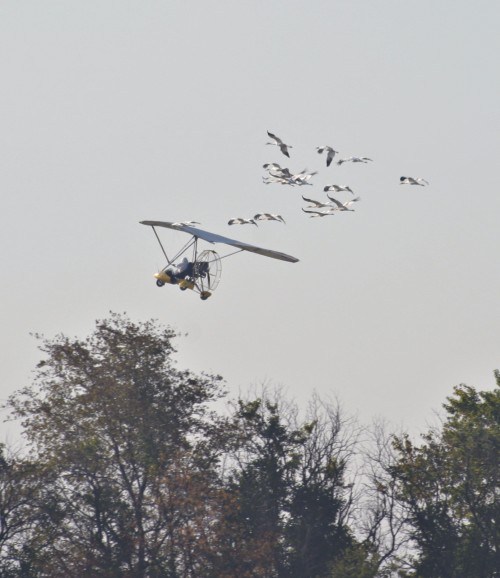
“Seldom content to follow, #10-06 constantly charges ahead to challenge the aircraft for the leadership. Most often he moves to the opposite wing from the rest of the birds and when he flies in front of the leading edge Joe can feel the pulse of his wing beats. “He is so predictable that I could monitor the birds on my left wing and know #10-06 was still on my right simply by the feel.”
Jan. 12, Moving Day: Yesterday he (and 11 others) made it only about halfway. The tired or stubborn birds spent the night in a travel pen and tried again on Jan. 12. In calm air and clear skies, all 12 birds who hadn’t cooperated yesterday took off with Joe. Joe tell’s about today’s flight with #10-06, his personal favorite:
“This morning, on our last flight together, he was in his usual place. We were not airborne 10 minutes when he was up to his usual tricks so I let him lead us to the pen. We circled the pen, slowly losing altitude. Sara was on the ground and we used her white costume as our target. We slowed just like we were landing. The birds dropped their legs in preparation and just as we were about to touch down I added full power and climbed out as hard as I could. . .but one bird continued to fly while all the others landed.
After 10 minutes I dropped down one more time and collected him on the wing. He was panting with the exertion of flying in warm air and we set up another long slow approach. This time when I added power, he tried to follow but was too tired. He circled a few more times and reluctantly landed next to the others. I made a point of not looking at his primaries. (Crane #10-06 can be identified in the air by the minor damage to the primary feathers on his right wing, or just because he is always in the lead.) Although it could have been any bird [it was #15-06], I like to think it was #10-06.” Migration complete!
“Chick #10-06 is one of the birds that made the entire trip to Florida under his own steam. He never dropped out and had to be crated, and never refused to follow us,” said Joe after the final flight.
Feb. 2, 2007: Crane #10-06 died when violent storms moved through central Florida during the night, killing all 17 chicks in the pen at Chass. Only #15-06 somehow managed to escape. Nineteen humans lost their lives in Florida the same night.
Click here to jump to the top of this page.
Crane #11-06
Sex: Female
Hatch Date: May 18, 2006
Personality and Characteristics: Migration Training – Chick #11-06 was the first bird to come from the Audubon Species Survival Center in New Orleans. She came to Wisconsin for flight school on July 6 in cohort two, the 5 chicks in the middle of the birth order. Very hot, dry weather meant days off with no training, and #11-06 wanted to stay in the pen when they trained again on July 18. Finally #11-06 went out by herself to stand on the runway south of the pen. But she also wanting to go to the swamp like a few of the other chicks did! Later, thanks to treats of grapes tossed by the puppet, the pilots were able to get all five chicks to follow. When they got back to the pen, all the chicks copied #11-06 and tried to go into the swamp!
On July 28, #11-06 was flapping hot on the heels of the trike as always. A great follower, it looks like she’ll soon be a great flyer too. But she’s still too fond of the swamp by the pen. Sometimes she escapes to spend some of her training time in the swamp. Then she comes back and follows for only a half circle. By mid August she was taking much more interest in the trike (ultralight plane) because she had figured out SHE could fly, too—and it was FUN!
The scary part for #11-06 was the stampede to the gate when the chicks heard the trike coming to pick them up for training. She stayed in the corner away from the gate, afraid to join the birds waiting eagerly for the gate to open. She’s very submissive. Laurie saw the problem. Like #11-06, Laurie remembered feeling left out and rushed as a school girl. She wanted to help the scared chick. Day after day, Laurie (always in costume) used her puppet (and treats!) to coax #11-06 to come nearer the gate and join group.
October 4 bought a new kind of lesson. The pilots took the birds to a travel pen they’d set up on another part of the refuge. They wanted to give the cranes a practice session going in and out of the travel pen, just like they’ll do on migration. But #11-06 would NOT go into the pen, despite a mountain of grapes to bribe her. She liked the runway though. The team worries about getting this very submissive chick to be a good follower of the plane during migration.
Marie says, “You you can rest assured that if one of the chicks is pecking at a costume or a boot, it is this little girl.” Will she become less submissive during migration?
History
First Migration South: Chick #11-06 left Wisconsin for her first migration on October 5th, 2006. She was one of the 17 birds who flew the whole first leg of the journey and landed safely at Stopover #1! Read day-by-day news about the flock’s migration to see what happens.
Oct. 23: After 7 days of being penned, #11-06 flew with Richard’s trike and and 3 other cranes. A mile from Stopover #4, she decided to land on her own. Richard landed with the other three, walked them to their travel pen, and then returned for the wayward #11-06. Read More.
January 12, 2007: Moving day! Chick #11-06 followed the ultralight planes Jan. 11 when the pilots tried to move the 18 chicks from the layover site to “Chass.” She was one of only six birds that cooperated! Hooray! Migration complete.
Feb. 2, 2007: Crane #11-06 died when violent storms moved through central Florida during the night, killing all seventeen chicks in the pen at Chass. Only #15-06 somehow managed to escape. Nineteen humans lost their lives in Florida the same night.
Click here to jump to the top of this page.
Crane #12-06
Sex: Male
Hatch Date: May 18, 2006
Personality and Characteristics: Migration Training: Chick #12-06 is the “top crane,” the dominant bird in his group. After this cohort got to Wisconsin for flight school, he was still aggressive and in charge. After two days off due to hot weather, #12-06 lagged behind all day or took off into the swamp. Pilot Richard tossed out grapes from the puppet while taxiing down the runway to try to coax #12-06 to follow. By the end of the session, he was following the trike with his 4 other cohort-mates. By July 28, he was bounding along after the ultralight with longer and longer strides.
By Aug. 7 the whole group is doing well, flying half circuits behind the trike then landing in the swamp. Most of the birds, including #12-06, will then quickly walk to the side of the runway to rejoin the group. With just a little more practice, they will be more able to stay aloft long enough to make it back to the runway. Then they will enjoy their morning exercise even more!
Bev adds that #12-06 is the biggest, tallest, and most muscular bird in his group. This helps him be the best flyer. He’s a dominant bird, but Bev says he doesn’t really act like Top Crane. He doesn’t throw his weight around a lot, and she believes this makes #12-06 a good leader.
History
First Migration South: Chick #12-06 left Wisconsin for his first migration on October 5th, 2006. He flew the whole first leg of the journey and landed safely at Stopover #1! Read day-by-day news about the flock’s migration.
October 14: After being in the pen for four bad-weather days, Marie thought the birds are getting antsy to leave. “Tempers are flaring, and this morning #12-06 and #6-06 were doing the ‘I’m bigger than you’ thing. Most times stretching their necks out is enough of a threat and one of the birds will back down and wander off. This time both started flapping and jumping at each other until the other birds formed a ‘fight ring’ around them. Just as I walked over to them, #6-06 decided he had had enough and walked away from #12-06. It seems to me that #12-06 is also turning out to be a bit of a bully. This seems odd since as a chick he was always so calm and never minded being around the other birds.
December 2: He’s just great on all the fly days. But now the birds hadn’t flown with the ultralight for 9 days. When they took off Dec. 2, Crane #12-06 had trouble crossing the Cumberland Ridge. It’s the highest point on the whole migration. He dropped out on top of the ridge. Charlie caught him, put him in a crate, and drove him on mountain roads to the next stop.
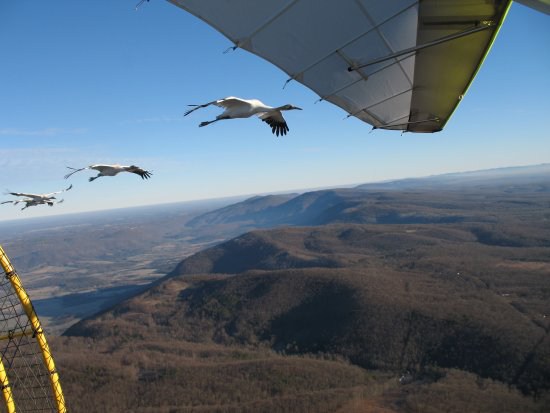
January 12, 2007: Moving day! Chick #12-06 followed the ultralight planes Jan. 11 when the pilots tried to move the 18 chicks from the layover site to “Chass.” He was one of only 6 birds that cooperated! Hooray! Migration complete.
Feb. 2, 2007: Crane #12-06 died when violent storms moved through central Florida during the night, killing all 17 chicks in the pen at Chass. Only #15-06 somehow managed to escape. Nineteen humans lost their lives in Florida the same night.
Click here to jump to the top of this page.
Crane #13-06
Sex: Female
Hatch Date: May 19, 2006
Personality and Characteristics: Migration Training – As a tiny chick she ran all over the place, but followed the costume and trike really well. She arrived in Wisconsin on July 6, 2006 with the rest of cohort 2. After a few days with no training due to very hot weather, all the birds were slow to get started on July 18. Crane-kid #13-06 lagged behind all day, struggling to follow the trike. Sometimes she took off into the swamp. Pilot Richard tried to tempt her by tossing out grapes from the puppet while taxiing down the runway. By the end of the session, she was following the trike with her other cohort-mates. By July 28, she looked more and more weightless each time she chased behind the ultralight. She will soon take flight!
August 5 was a good training session with all the birds flying. In fact, #13-06 flew a circuit before the ultralight even revved up! Unlike previous attempts, she made it all the way back to the runway and didn’t end up in the marsh for a change. Looking good!
By August 15 all birds in this group were doing short circuits with the trike. And #13-06, the best flyer in the group, flew with the ultralight for 2 large circles in the air above the training grounds!
Bev says #13-06 is like a typical “middle child” because she doesn’t draw attention to herself and doesn’t make trouble.
What is so neat about #13-06’s leg band?
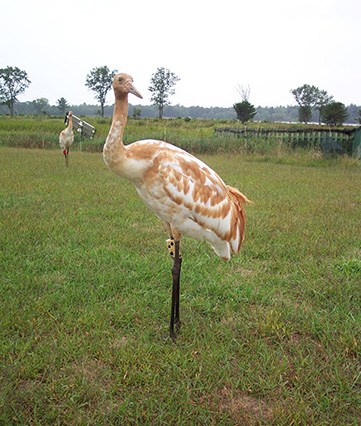
Marie explains: “Both #13-6 and #14-06 had white leg bands. When they were given their temporary radio transmitters before migration, how would we tell them apart? Sara had the idea: She painted black spots on Chick #13-06’s transmitter. We call this chick our little “holstein”!
This chick is Marie’s personal favorite. It’s because of the success she had with #13-06 when first letting her out of the indoor pen when she was a tiny chick at Patuxent. “Most chicks are reluctant to come out of the scary doorway,” explains Maire, “but she burst out of her door and ran along like crazy after me. She was unsteady on her feet (being only a few days old) but was so excited to be outside that she was running full speed, wings out, weaving from side to side.
Marie says #13-06 is quite submissive and doesn’t stand up for herself when another bird comes up to push her out of the way. “Yet somehow, she is still almost always one of the closest birds to me when I go into the pen. (I would like to think its because she likes me, but more likely it is that I sneak her an extra few corn kernels).”
History
First Migration South: Chick #13-06 left Wisconsin for her first migration on October 5th, 2006 and flew the whole first leg of the journey. Not only that, but she was the first to land at Stopover #1! Read day-by-day news about the flock’s migration to see what happens.
Oct. 31: On this no-fly day, Marie went to the pen to check the birds: “Most of the birds were peacefully eating and drinking together and peeping contentedly. That is, until #13-06 picked up a golf ball sized seedpod that #4-06 wanted. #4-06 went after it as #13-06 ran toward a water bucket to clean off her find. Then #6-06 ran in to grab the seed, but #13-06 gulped it down too quickly. #6-06, obviously disgruntled that she didn’t get any, gave #13-06 a peck on the back. That seemed to restore the peace, and by the time we left the pen the three birds were foraging side by side.”
Dec. 15: All birds came out of the pen eager to fly, but the warm, humid air soon made the exercise of flying VERY TIRING. The heat and humidity was too much for crane #13-06, who gave up and landed. She finished the trip in a box in Charlie’s tracking van. It was a rough flight for everyone, but all are safe.
January 12, 2007: Moving day! Chick #7-06 followed the ultralight planes Jan. 11 when the pilots tried to move the 18 chicks from the layover site to “Chass.” She was one of only six birds that cooperated! Hooray! Migration complete.
Feb. 2, 2007: Crane #13-06 died when violent storms moved through central Florida during the night, killing all 17 chicks in the pen at Chass. Only #15-06 somehow managed to escape. Nineteen humans lost their lives in Florida the same night.
Click here to jump to the top of this page.
Crane #14-06
Sex: Male
Hatch Date: May 20, 2006
Personality and Characteristics: A Canadian Whooping crane! This little fella came from the Devonian Center at Calgary Zoo. Migration Training – Making good progress in flight school, he was one of the chicks to eagerly follow the trike on July 18 when others would rather go off to the swamp. By July 28, he looked like he’d soon take off and fly.
By August, the chicks are so eager to fly that they often forget to wait for the trike. Charging out of the pen, they take off before the pilots have a chance to get moving. But not #14-06, who likes to dawdle. His usual act was pretending he didn’t see the trainers in costume so he could stay in the wet pen instead of coming to lessons. On Aug. 7, #14-06 was still lollygagging in the wet pen after the others ran out. It looked like he wanted nothing to do with training. But, after a few minutes, he walked out on his own and quickly joined the group. Still, he kept looking to the swamp and trying to ignore the trike (ultralight plane) during training.
But when #14-06 learned to fly, his dawdling and ignoring the trike changed. He found out it was FUN to be able to fly. It became fun to follow the trike. Now he’s a good flier and a good follower. He’s ready for migration!
History
First Migration South: Chick #14-06 left Wisconsin for his first migration on October 5th, 2006. He flew the whole first leg of the journey, and he was the second one to land at at Stopover #1! Read day-by-day news about the flock’s migration to see what happens.
Oct. 23: After 7 days of being penned, #14-06 had a little trouble climbing to cross an 800-foot ridge soon after takeoff. After two landings with Brooke’s group to rest, he dropped out again. He was finally captured on the ground by Richard and Charlie. They drove him by road to the next stopover.
Dec. 18: #14-06 has been boxed and driven only one time–until today! Four birds, including #14-06, dropped out on the way to the last stop before the birds reach their layover pen. He was captured, boxed, and driven to the Gilchrist County, FL. travel pen. He will fly to the layover pen with his flock tomorrow (Dec. 19)!
Jan. 12, Moving Day: #14-06 made it almost half way on the first moving day before he (and several others) had a rest stop. They took off again and still landed short —still 10 miles from the Chass pen. They were too tired to try again, so they spent the night in a travel pen with others that had to be crated and brought to the same site. The next morning in calm air and clear skies, all 12 “late” birds took off with Joe’s plane. Their final flight with the ultralight lasted a charming 18 minutes. They landed at their final winter home at “Chass,” where six cooperative flockmates had arrived the day before. Migration finally complete!
Feb. 2, 2007: Crane #14-06 died when violent storms moved through central Florida during the night, killing all 17 chicks in the pen at Chass. Only #15-06 somehow managed to escape. Nineteen humans lost their lives in Florida the same night.
Click here to jump to the top of this page.
Crane #15-06
Sex: Male
Hatch Date: May 20, 2006
Personality and Characteristics: Migration Training – He came to Wisconsin for flight school on July 6 in cohort two, the 5 chicks in the middle birth order. On July 18, after two days off in hot weather, he was eager to follow the trike during training. But instead of going back into the pen after the flight, he jumped the fence and ran off to the swamp! When Marie rushed into the swamp to get him, he happily followed her back to the pen. Did he get scared by himself in the swamp?
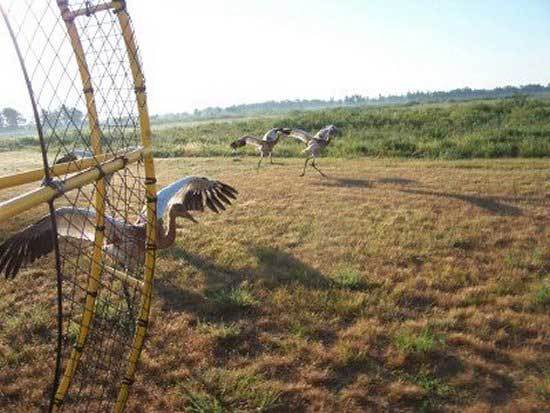
Chicks are running and flapping after the ultralight plane on July 18. Soon they will be able lift off and fly for short distances. With practice, they’ll be ready for their 1200-mile migration in October!
By July 28 it was clear that Mr. #15-06 has a mind of his own. He joined his cohort mates on the first run, but took off for the marsh on his own instead of staying with the group. After the rest of the birds finished training, #15-06 finally came out of the marsh and got some private lessons from Joe. His flight instructors hope he will pay better attention tomorrow!
By August, the chicks were so eager to fly that they often forgot to wait for the trike. Charging out of the pen, they take off before the pilots have a chance to get moving. That happened on Aug. 7 with #15-06, who took off and promptly landed in the swamp. He came out right away, though, and joined his group for training. Two days earlier, pilot Bev said, “Training ended on the same note it always does, with #15-06 wandering away into the marsh. Brooke and I waded in after him, and after a lot of coaxing, we finally got him back on the runway and into the pen. Boy, that bird is independent!”
On September 29, Bev had to play “Swamp Monster” to scare #15-06 into flying with the trike instead of landing in the swamp. Bev’s Swamp Monster act worked, and #15-06 joined the others and flew several more circuits. On October 1, all 18 cranes charged out of the pen and flew well for at least 20 minutes! Migration is only a few days away.
History
First Migration South: Chick #15-06 left Wisconsin for his first migration on October 5th, 2006. He flew the whole first leg of the journey and landed safely at Stopover #1! Read day-by-day news about the flock’s migration to see what happens.
Oct 14: To entertain the birds when they were stuck 4 days at Stopover #2, the team gave them some corn cobs.
Oct. 23: The trackers were put to the test soon after takeoff today! News about #6-06, #8-06, #15-06 and #18-06 landing in the field came through the radio shortly after departure from Stopover #3. With the exact location of these chicks provided by top cover pilots Don and Paula, trackers Bev and Sara went to the the birds right away to secure their safety. They were crated and driven to Stopover #4.
Nov. 3: Chick #15-06 was the culprit who led the other birds out of formation several times in rough air today. He caused a lot of worry and trouble for the pilots, trying to keep the birds on course. Finally, a pilot zoomed in and picked up the independent chick and flew alone with him. Richard said, “Without #15-06 I found the birds much more eager to follow and we really picked up the pace.” What do you suppose #15-06 had in mind?
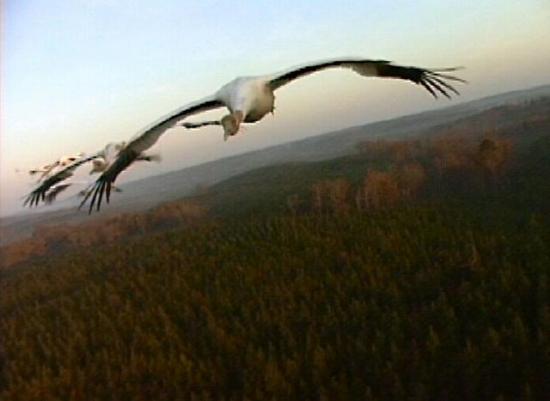
Dec. 18: #15-06 is causing more worry. Today he disappeared! The birds were reluctant to fly and four of them dropped out on the way to the last stop between them and their layover pen. #15-06 was the only one not found. He was last seen thermalling (rising and soaring upwards on currents of warm air, as cranes naturally do in the wild) with about 2 hours of daylight left.The team hopes he found a safe place to roost. They will continue the search tomorrow, the day the migration will FINISH.
Dec. 19: The team and flock took off without the missing #15-06. The 17 birds landed at the layover pen and will stay there until early to mid-January when they will take their last flight a few more miles away to the chicks’ usual winter pen at “Chass” NWR. By mid-morning today, trackers were airborne to search for the radio signal of #15-06. Today’s air and ground search was unsuccessful, but the team is confident that he’ll be found and reunited with his flock.
Dec. 20: FOUND! Top cover pilots Don and Paula took one more turn looking for #15-06 and found his signal! Looking down, they saw several small lakes. Sure enough, there was #15-06 tucked away in a remote area on one of the lakes. They radioed Richard (who was tracking on the ground about an hour behind them) the location and said #15-06 seemed to be waiting patiently for someone to come for him. Richard found the spot within an hour. He put on his costume. Then, out of sight of the van, he turned on his vocalizer. Chick #15-06 flew over and landed next to him as if to say, “It’s about time someone showed up!” After a ride in the van, he’s with his flock mates at last!
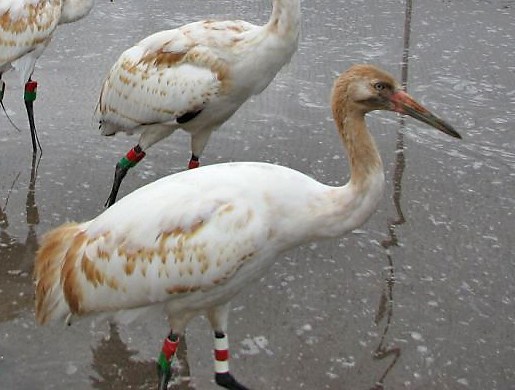
#15-06 in Florida. Photo Sara Zimorski, ICF
Jan. 12, Moving Day: Yesterday #15-06 (and 11 others) didn’t want to follow the trike and made it only about halfway. They spent the night in a travel pen with others that had to be crated and brought to the same site. They are still 10 miles from the final pen. The next morning in calm air and clear skies, all 12 “late” birds took off with Joe’s plane. Their final flight with the ultralight lasted a charming 18 minutes. They landed at their final winter home at “Chass,” where six cooperative flockmates had arrived the day before. All but one bird landed immediately. It was #15-06! Joe flew circles with this eager flyer for more than 10 minutes before #15-06 was finally persuaded to land. They’re all safe at their final winter home at “Chass.” Migration finally complete!
The Sole Survivor: Class of 2006 Ultralight-led Cranes
On Feb. 2, the team thought #15-06 died with the other 17 chicks when violent storms moved through central Florida during the night. (As protocol requires, all 18 birds were in the top-netted enclosure as a protection against the older whoopers visiting the pen site, but only 17 carcasses were removed after the storm.) Then radio signals from #15-06’s transmitter were heard the night of Feb. 3 and again on Feb. 4 near the Chass pen site. Trackers went into action. Later that day, they saw him with two sandhill cranes about 20 miles north. The sole survivor of the ultralight-led class of 2006 is #15-06. After the stunning loss, it was a thrilling discovery and ray of hope.
How did #15-06 survive? No one knows. “One thought is that it was near a gate… in the pen and water hitting it sort of jarred it a bit, and the crane slipped out,” said Jim Harris of ICF.
What will happen next? The bird is a bit young to be on its own, but managing #15-06 alone at the old Chassahowitzka pen site would not have been easy for workers or good for the bird, according to Sara (ICF). As for his first migration back to Wisconsin in a few months, Sara said, “He should know the way, but we’ll keep a very close eye on him.”
Captured. On Feb. 11, 2007, an update from trackers was posted by Liz on the Operation Migration Website: During the week, #15-06 kept company with both Sandhills and Whoopers. He was very active, flying from county to county. He kept returning to the Halpata pen site where the chicks stayed before moving to Chass. Because he was dry-roosting and therefore in great danger of attack, trackers decided to capture #15-06 and move him to safety. The Tracking Team divided the pen into two sections because #5-01 was also being held at the Halpata pen after being removed twice from Homosassa State Wildlife Park. Trackers moved #15-06 into the newly created half of the pen. Both birds are given food and fresh water and are being checked daily. Some people are calling #15-06 Maverick and some are calling him Houdini! The team is thinking about what to do next.
Set Free! On March 3, Bev and Brooke drove out to the Halpata pen to box #15-06 for release. (They had tried to release him two days prior by letting him out of the pen, but he just ran off into the woods and wouldn’t fly. With all the bobcats in the woods, they couldn’t allow him to stay there, so back in the pen he went.) When#15-06 was boxed up, Bev and Brooke drove to meet Richard in the same marsh where #15-06 had been flying when they found him after the storm; they figured it would be a good spot for him. Richard and Brooke carried the box to the edge of the marsh and released #15-06, who spent the afternoon exploring his freedom, flying around and seeming at home. What a strange winter for him! Now he is free at last. He was still on Halpata Tastanaki Preserve as of March 24. He was usually in a small wetland in a wooded area.
Spring 2007: Chick #15-06 remained on Halpata Tastanaki Preserve, Marion County, Florida. He was usually alone in small wetlands, openings in wooded areas, or near the pensite.
On April 30, Operation Migration leaders announced: “It is with immense sadness we report that #15-06, the only surviving member of the Class of 2006, was found dead by Mary Barnwell (Southwest Florida Water Management District) earlier today.” The remains were found on Halpata Tastanaki Preserve, Marion County, Florida.
He had last been observed alive at this location during an aerial survey on April 21. He was alone and appeared to be hiding in thick scrub shrub in a small marsh NE of the Halpata pensite. This behavior was not normal, and he probably died shortly after that observation was made. He was not found during a ground search later that afternoon or in several searches later in the week, probably because of reduced radio transmission while he was on the ground. His radio signal was again detected from the air during an aerial survey on 29 April, and his remains were found during a ground search the next day in inappropriate habitat with thick cover. Remains were sent to Dr. Marilyn Spaulding at the University of Florida’s College of Veterinary Medicine for necropsy. She was not able to pinpoint a cause of death, but believed that predation was not a probable cause of death.There were clues that #15-06 may have been sick from eating metal.
Click here to jump to the top of this page.
Crane #18-06
Sex: Male
Hatch Date: May 27, 2006
Personality and Characteristics: This male came from the captive breeding program at the Calgary Zoo.
Migration Training – “Chick #18-06 is a little momma’s boy,” said Barb, one of the caretakers at Patuxent. “He wants to be the only bird near the costume and is obsessed with the puppet. He hatched with very crooked toes. His toes were taped to help them grow straight. Even though he cries when he sees Momma, he is aggressive to other birds. He would like to be the top dog (top crane) of Cohort 3, but #22-06 is keeping him from reaching that goal.”
He came to Wisconsin on July 20 with the cohort three birds. On August 5, Bev watched #18-06’s great bounding leaps and felt sure he would lift off in flight in the next few days. “The best part for me this morning was when 5 of last year’s white birds came onto the runway to see what was up. Our darling little chicks wanted nothing of this and became quite aggressive towards the larger birds. Fiesty #18-06 chased, showed displays of aggression, and even managed to drive off one of the big white whoopers.”
By August 15 #18-06 was flying the length of the runway in ground effect. By August 17 he was able to fly the length of the runway, and all the other chicks were flying too.
Sept. 1: The pilot reported what happened when the two adults in the First Family showed up on the training strip and began to unison call. “This must have infuriated #18-06, for he rushed over to one of the adults (Mama, I think) and they began to jump-rake each other without making any real contact. While Brooke ran over to save #18-06 from becoming squashed like a grape, I ran interference for the other chicks who were now racing over to join in the fray.” Luckily, no birds were hurt and the ultralight chicks followed costumed trainers (with treats) back into their pen.
By mid-September, #18-06 was still among the three most aggressive chicks. When the three cohorts were finally together, his style had become a calm leadership.
History
First Migration South:
Day 1: Chick #18-06 left Wisconsin on his first migration on October 5th, 2006. He was one of the 17 birds who flew the whole first leg of the journey without pause and landed safely at Stopover #1!
Oct. 10: After 4 days stuck at the first stopover, did #18-06 need to get back in practice? He got tired and dropped out when the birds flew again on Day 6. The ultralight plane moved in to offer #18-06 some help. The tired bird made it to within 4.6 miles of Stopover #2. Then he dropped out again.The bird was captured, crated, and trucked the rest of the way to Stopover 2, for a total move of 18 miles.

The team gave the chicks a few corn cobs to play with. See them? Marie tells about it: “We put the partially shucked cobs on the ground and watched the birds approach them, cautiously at first. In a matter of seconds the cobs were being tossed and picked over, corn sent flying from strong pecks. (You wouldn’t believe how strong these chicks can peck until one pecks on your boot. It isn’t long before a bruise appears.)
Oct. 15: All the birds took off today, but the ground crew always stays put for at least 10 minutes to be sure that none of the birds turn and head back to the pen. Today #6-06 and #18-06 turned back. Thanks to the Swamp Monster (aka Bev) to keep them from landing, a pilot was able to pick up the two that returned but they circled back again. Finally, Charlie caught them and drove these two all the way to Stopover #3 in special boxes in the van.
Oct. 23: The trackers were put to the test soon after takeoff today! News about #6-06, #8-06, #15-06 and #18-06 landing in the field came through the radio shortly after departure from Stopover #3. With the exact location of these chicks provided by top cover pilots Don and Paula, trackers Bev and Sara went to the the birds right away to secure their safety. They were crated and driven to Stopover #4.
Oct. 24: Hooray! In the best day so far for all the birds, #18-06 finally decided to fly alongside the lead pilot all the way. This migration leg from the 4th to the 5th Stopover was the best so far. No birds dropped out, or returned, or got crated!
Dec. 3: He made it over the Cumberland Ridge on Dec. 2 but the next day he wasn’t a willing flyer. He was one of the three birds that were boxed and driven from Hiwassee Refuge to Gordon County, Georgia on Dec. 3.
Jan. 12, Moving Day: #18-06 made it almost half way on the first moving day before he (and several others) had a rest stop and still dropped out short of the final stop by 10 miles. They were too tired to try again, so they spent the night in a travel pen with the others that had been crated and brought to the same site. The next morning in calm air and clear skies, all 12 birds who hadn”t cooperated yesterday took off with Joe’s plane. Their final flight with the ultralight lasted 18 minutes. They landed at their final winter home at “Chass,” where six flockmates had arrived the day before. Migration finally complete!
Feb. 2, 2007: Crane #18-06 died when violent storms moved through central Florida during the night, killing all 17 chicks in the pen at Chass. Only #15-06 somehow managed to escape. Nineteen humans lost their lives the same night.
Click here to jump to the top of this page.
Crane #19-06
Sex: Female
Hatch Date: May 28, 2006
Personality and Characteristics: Also came from the Calgary Zoo captive breeding center.
Migration Training as a Chick: While #19-06 was at Patuxent WRC (before she came to Wisconsin for flight school at about 8 weeks of age), her caretakers said: “She has never gotten over the 7 deer she saw two weeks ago in the training field. She is very alert, constantly looking for danger. Deer certainly aren’t a predator of cranes, but the chicks get scared of unusual things. Even a little bunny can send them running and it takes a long time for a chick to forget a bad experience. #19-06 is a very pretty bird, very slender and tall. She looks very elegant. She likes to forage in the pond.” She gets along well with #20-06.
She came to Wisconsin on July 20 with the cohort three birds. This group was supposed to arrive on July 13, but they had to stay behind at Patuxent until they learned how to get along better with each other. These five all seem to be troublemakers. On August 5, pilot Bev watched #19-06’s great bounding leaps and strong flapping and felt sure she would lift off in flight that day or very soon.
By August 15 she was flying the length of the runway in ground effect. By August 17 she was able to fly the length of the runway with the rest of the chicks in cohort three, the youngest birds. From then on, she made good progress. She’s still feisty, but not as bad as #18-06 and #22-06.
History
First Migration South: Read day-by-day news about the flock’s migration to see what happens.
Chick #19-06 left Wisconsin on her first migration on October 5th, 2006. She was one of the 17 birds who flew the whole first leg of the journey and landed safely at Stopover #1!
“Chick #19-06 is our little ghost bird, says Marie. “Always in the middle, not causing any trouble and hardly ever noticed. Like in most families, our chicks that get noticed are the outgoing or troublesome ones. Those quietly going about their business (like #19-06) are often left alone. But I like this bird because she is so easy-going and I try to sneak her extra corn when the other “kids” aren’t watching!”
Oct. 23: After 7 days of being penned, #19-06 had a little trouble climbing to cross a ridge soon after takeoff. She and 2 other birds landed with Joe to rest. Crane #19-06 did well after a second take off, flying on Joe’s wingtip. With only two birds, Joe climbed to 2,500 feet and they made it to the next stopover.
Nov. 17: When the ground crew arrived at the travel pen they discovered #19-06 was on the outside. There was no clue as to how she escaped. The ground crew will check the pen and gates to see if they can figure out what happened.
Dec. 9: Here’s #19-06 surfing the leading edge of the aircraft wing on Day 67 of the migration!
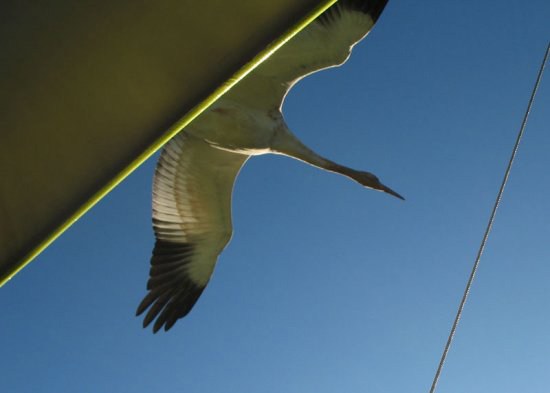
January 12, 2007: Moving day! Chick #19-06 followed the ultralight planes Jan. 11 when the pilots tried to move the 18 chicks from the layover site to “Chass.” She was one of only 6 birds that cooperated! Hooray! Migration complete.
Feb. 2, 2007: Crane #19-06 died when violent storms moved through central Florida during the night, killing all 17 chicks in the pen at Chass. Only #15-06 somehow managed to escape. Nineteen humans lost their lives the same night.
Click here to jump to the top of this page.
Crane #20-06
Sex: Female
Hatch Date: May 28, 2006
Personality and Characteristics: Another Canadian crane from the Calgary Zoo captive breeding program.
Migration Training as a Chick: While #20-06 was at Patuxent WRC (before she came to Wisconsin for flight school at about 8 weeks of age), her caretakers said: “Chick #20-06 still has hope of something happening to #18-06 and #22-06 so she can raise her position in the pecking order! Birds sometimes take advantage of a situation such as fighting to get to dominate another bird. For example, the other day #22-06 was being very aggressive to #18-06, who had been bathing in the pond. Chick #20-06 thought she could get in on the action when the other two were hassling. Luckily, we human handlers (in white costumes) stopped things before they got out of hand.” She gets along well with #19-06, but fights with the other chicks through the fence.
She came to Wisconsin on July 20 with the cohort three birds (all of them still troublemakers). By August 15 she was flying the length of the runway in ground effect. The pilots believe #20-06 is by far the best bird of her group of the five youngest birds. August 19 she was flying well. She had even circled above the runway with the aircraft!
See a photo of #20-06 in a contest with #18-06 on September 1.
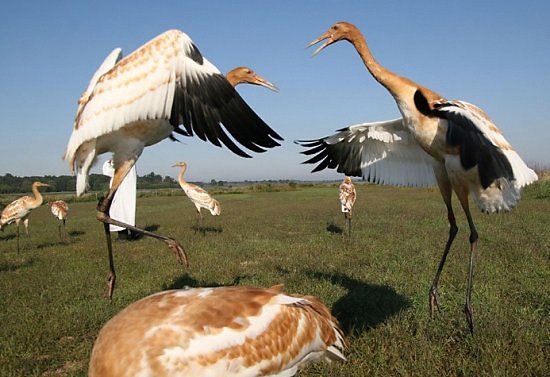
On September 1, chicks #20-06 and 18-06 had a friendly sparring match. They are jump-raking without actually touching. That’s good, because cranes have wicked claws. Do you see the “costumes” watching from a distance?
By mid-September, #20-06 (along with #18-06 and #22-06) was still among the three most aggressive chicks.
History
First Migration South: Chick #20-06 left Wisconsin for her first migration on October 5th, 2006. She flew the whole first leg of the journey and landed safely at Stopover #1!
Dec. 18: #20-06 has flown like an expert for the whole migration until today! Four birds, including #20-06, dropped out on the way to the last stop before reaching their layover pen. She was captured and boxed to the Gilchrist County, FL. travel pen. She will fly the last leg of the journey with her flock (except for the still-missing #15-06) tomorrow!
Jan. 12, Moving Day: #20-06 only made it half way on the first moving day before she (and several others) had a rest stop, another takeoff and still landed short of the final stop by 10 miles. She and the other tired birds spent the night in a travel pen with a few others that had been crated and brought to join them. The next morning in calm air and clear skies, all 12 birds who hadn’t made it on moving day #1 took off with Joe’s plane. Their final flight with the ultralight lasted 18 charming minutes. They landed at their final winter home at “Chass,” where six flockmates had arrived the day before. Migration finally complete!
Feb. 2, 2007: Crane #20-06 died when violent storms moved through central Florida during the night, killing all 17 chicks in the pen at Chass. Only #15-06 somehow managed to escape. Nineteen humans lost their lives the same night.
Click here to jump to the top of this page.
Crane #22-06
Sex: Male
Hatch Date: May 31, 2006
Personality and Characteristics: Another Canadian crane from the Calgary Zoo captive breeding program. Was sent as an egg to the Patuxent Wildlife Research Center in Maryland.
Migration Training as a Chick: While #22-06 was at Patuxent before he came to Wisconsin for flight school, his caretakers told what he was like: “MEAN! Has always had aggression issues since he was just a little guy. If you break up a fight he’s having with one bird, then he will just go after ANY bird he sees. He was so mad that he was even aggressively pecking the costumed handler’s puppet head. In the group of five youngest, chick #22-06 and #18-06 have had their share of battles, but so far #22-06 is still the top crane. What can we say about #22-06 but LOOK OUT WORLD ‘CAUSE HERE HE COMES!”
The youngest five cranes had to be kept longer at Patuxent because they had to learn to get along before they are transferred to Wisconsin for flight school. Chick #22-06 is a big danger to the other chicks. The youngest five (cohort 3) finally arrived in Wisconsin for flight school on July 20!
Being so much younger, #22-06 often lags behind. Some training sessions all by himself with the pilot and trike gave him more practice flying. By August 17 he was taking short flights.
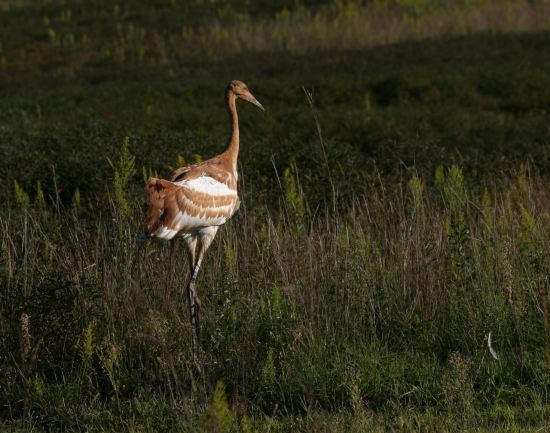
Photo: Operation Migration
Tough Guy! Chick #22-06 didn’t mellow. On August 29 he chased off #11-02, the adult male and new father of the flock’s first chicks. The new papa got mad when the ultralight and some flying chicks buzzed his family during training. He followed the trike-led cohort back to Site 1. Bev said, “Upon landing, Daddy-O took an aggressive stance towards the young ‘uns, and boy-oh-boy was he shocked when #22-06 fought back. I’ve never seen a more surprised white bird! It was bad enough that #22-06 stood him down, but then the whole gang got in on the scuffle and chased poor papa away. Way to go Chicklins!”
By mid-September, #22-06 (along with #18-06 and #20-06) was still among the three most aggressive chicks. “He always wants to be the center of attention, says Marie. “He will give the other chicks a good peck if they are getting too close or if they are where he wants to be (around the footbath, costume or feeder).”
History
First Migration South: Chick #22-06 left Wisconsin for his first migration on October 5th, 2006. He flew the whole first leg of the journey and landed safely at Stopover #1! Read day-by-day news about the flock’s migration.
Oct 14: To entertain the birds when they were stuck 4 days at Stopover #2, the team gave them some corn cobs.
December 2: He made it over the Cumberland Ridge!
Jan. 12, Moving Day: #22-06 made it almost halfway on the first moving day before landing in the woods. Tracker Stacey found the tired bird. She crated and drove him to join the others where they’d landed short in Citrus County—still 10 miles from the Chass pen. But they were all too tired to try again, so #22-06 and the others spent the night in a travel pen The next morning brought calm air, clear skies and all 12 birds who didn’t cooperate yesterday took off with Joe’s plane. Their final flight with the ultralight lasted 18 minutes. They landed at their final winter home at “Chass”, where six of the flockmates had arrived the day before.
Feb. 2, 2007: Crane #22-06 died when violent storms moved through central Florida during the night, killing all 17 chicks in the pen at Chass. Only #15-06 somehow managed to escape. Nineteen humans lost their lives the same night.
Click here to jump to the top of this page.
Crane #23-06
Sex: Female
Hatch Date: May 31, 2006
Personality and Characteristics: This youngest of the ultralight-guided cohort comes from the captive breeding stock at Patuxent Wildlife Research Center.
Migration Training as a Chick: While #23-06 was at Patuxent WRC, her caretakers said: “Chick #23-06 is just the cutest, sweetest little girl. In her younger days #23-06 was quite a handful. She was a little meanie, but she has come along way. She knows she’s in a group that has issues! She is very content to just go find her own little corner of the world (pond) and do her own thing. She is a good forager, and likes the water and likes a good shady spot to sit in. Often she is hard to see on camera because she likes to sit right under the dome of the camera. She must think it looks like the heat lamp she had when she was growing up.”
When she was really little, #23-06 was afraid of the trike, but now she is a little champ. In her cohort of five youngest birds, she gets along well with #19-06 and #20-06, EXCEPT when the weather is hot!
She arrived in Wisconsin for flight school on July 13 with the four others in the youngest group. All of them started out as troublemakers. They needed extra time at Patuxent so they could try to get along better without fighting.
On August 5, #23-06 didn’t want to come out of her pen for training. Her four flock mates trained with the trike, and finally she came out and joined the group. Bev said, “The best part for me this morning was when five of last year’s white birds came onto the runway to see what was up. Our darling little chicks wanted nothing of this and became quite aggressive towards the larger birds. Chick #23-06 got in on the act and she chased off one of the big guys too.”
The pilots gave #23-06 some practice flying behind the trike all by herself because she is so young and lags behind. It helped! She was taking short flights by August 19.
Chick #23-06 is gaining confidence. She did a crouch-threat to Laurie. She probably thinks, “Oh GOOD. Finally there’s something I can pick on!” Laurie was proud of her for stomping at the costume. She said, “It’s amazing because no one taught her this behavior. She just knew it automatically!” She’s the smallest and most submissive, so she only acts tough to someone who won’t be a threat to her.
History
First Migration South: Chick #23-06 left Wisconsin for her first migration on October 5th, 2006. She flew the whole first leg of the journey and landed safely at Stopover #1! Read day-by-day news about the flock’s migration to see what happens.
Oct. 15, Day 11: All the birds took off, but #23-06 (and a few others) got tired. She landed in a clearing amid a forest on top of a hill. Flying chase, Joe followed her down. On Joe’s first try he was able to get her back up in the air, but she couldn’t quite make it over the trees. After letting her rest, Joe tried another take-off. It worked! He led #23-06 over the trees and they both landed in front of the travel pen in Stopover site #3, safe and sound.
Oct. 31, Day 27: When Marie and Laurie visited the birds, a few of them flapped their wings while jumping up or running when the “costumes” were in the pen. Laurie wrote: “Little #23-06 started to flap her wings while running back and forth from one side of the pen to the other. This usually shy chick had one quarter of the pen all to herself -like a stage – while the other 17 chicks and 2 handlers scattered into the ‘audience’ area. The behavior of #23-06 was so intriguing that all the audience members were moving our heads along with the movement of the modern dancer-like #23-06. It was a captivating sight.”
Dec. 18: Since that one event on Oct. 15, #23-06 has flown every part of the whole migration until today. Four birds, including #23-06, dropped out on the way to the last stop before reaching their layover pen. She was captured and boxed to the Gilchrist County, FL. travel pen. She will fly the last leg of the journey with her flock (except for the still-missing #15-06) tomorrow!
January 12, 2007: Moving day! Chick #23-06 (along with #04-06 and #06-06) refused to follow the ultralight planes today when the pilots tried to move the 18 chicks from the layover site to “Chass.” #23-06 was boxed and taken to a travel pen in Citrus County for overnight with other chicks that quit flying before they reached Chass. The next day was better and #04-06 flew with Joe and 11 other chicks the last 5 miles to their final winter pen. Home!
Feb. 2, 2007: Crane #23-06 died when violent storms moved through central Florida during the night, killing all 17 chicks in the pen at Chass. Only #15-06 somehow managed to escape. Nineteen humans lost their lives the same night.
Click here to jump to the top of this page.
Group Two: Direct Autumn Release (DAR) cranes
The DAR method also involves costume handlers raising the young crane chicks in the field. The difference is that prior to the fall migration period, the young cranes are released to form associations with older, experienced Whooping cranes in hopes they will guide the younger cranes to a safe wintering location.
Crane #26-06
Sex: Male
Hatch Date: May 25, 2006
Personality and History
Before Release – Chick #26-06 began flying in the middle of August. How old was he then? This chick is the Top Crane in the pecking order among his DAR flock mates. He is the leader of the pack, but he doesn’t use force very often. (It is fairly normal for the second in command to be more active and tough in keeping everyone else in line.)
The DAR chicks had their health checks on October 4. In addition, #26-06 got a temporary radio transmitter/band placed on his leg in case he flies from his pen site and trackers don’t know his whereabouts.
Oct. 17, 2006: Dr. Richard Urbanek said the DAR birds received their permanent leg bands. Chick #26-06 and the other four will be released as soon as they get used to their new leg bands and transmitters. Their freedom is near! Will they hang out with, and then follow, the older whooping and sandhill cranes to learn their migration route?
October 21: Chick #26-06 (with #28-06) was set free on the Wisconsin refuge where it spent its first months of life. The two newly released chicks quickly returned to the pool in their rearing area, and remained there to roost. The next day they visited with the First Family, also at home on the refuge (until fall migration).
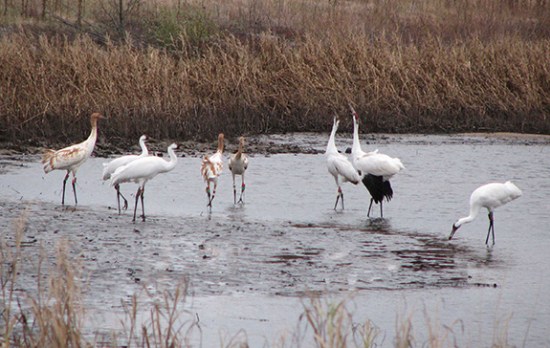
Look who joined parents 11-02 and 17-02 with their chick on October 22. Can you find newly-released chicks DAR 26-06 and 28-06? (The chicks still have tawny feathers.) Also visiting the first family are cranes 7-03, 12-05 and 19-05. Photo: Richard Urbanek
History
Fall 2006 First Migration: On October 28, DAR chick #26-06 left Wisconsin with #28-06 on their first migration — moving too fast for the ground tracker! PTT readings from #28-06 for Oct. 29 and 30 showed him in southern Indiana! A roost check on October 30 confirmed that #26-06 and #28-06 stayed together. They were seen Oct. 31 and again Nov. 25 in Indiana, feeding mainly in harvested cornfields with hundreds of sandhill cranes. On December 4 they continued migration to Hiwassee Wildlife Refuge, in Tennessee.
They left Hiwassee December 7 and were detected Dec. 8 in FLORIDA. They are moving around a bit, but staying in areas where the new Eastern flock spends the winter. (All four 2006 DAR chicks arrived in Florida on the same day!)
DAR chicks #26-06 and #28-06 were with wintering sandhill cranes in Pasco County, FL at the end of December. On Jan. 12 they flew to the Chass pen site for a quick visit before flying off to a Lake in Hernando County.
Spring 2007: Began migration (with #28-06) from Pasco County, FL on March 24.
They flew to Thomas County, Georgia that day. They roosted in Tennessee on the nights of March 25 and 26. They were grounded by rain and poor migrating conditions in Davies County, Indiana for the rest of the week. On April 1 the two separated. DAR 26-06 remained behind while DAR 28-06 continued migration to Pulaski County, IN.
Sad news came 12 days later. DAR #26-06 was found dead at the edge of a lake in Davies County, Indiana, on April 13. He apparently died from a neck wound inflicted by a predator. He had last been observed alive at the same site on the previous afternoon. The carcass was sent to the National Wildlife Health Center, Madison, Wisconsin, for necropsy.
Click here to jump to the top of this page.
Crane #27-06
Sex: Male
Hatch Date: May 28, 2006
Personality and History
Before Release – ICF’s Marianne Wellington says: “He has always been fairly independent. He is easy to recognize since he hatched with a white toenail on his middle toe. He might be considered the rebel. He is willing to test his parents’ tolerance. He often wandered off just a little more than the others and never seemed as interested in coming back to us “parents” in the white costumes. He was more interested in the adult cranes around! Then he thought he could take on adult #2-01. She put him in place several times. The last time she knocked #27-06 flat on the ground and was about to jab him when the costume stopped the attack. As soon as #27-06 got to his feet, he ran quite a distance away. He has been more interested in the costume since then, and he’s often one of the first chicks to come to the costume when the vocalizer played the crane call that means Come here. It’s okay. You’re safe.
“He still is interested in the wild birds. He chased ducks just to watch them fly. I also wonder if he realizes his costume parent isn’t the real thing (we don’t look like the adult whooping cranes). We wonder if he will try to release himself by deciding to fly with #2-01 or sandhill cranes here at the refuge.”
The DAR chicks had their health checks on October 4. In addition, #27-06 got a temporary radio transmitter/band placed on his leg in case he flies from his pen site and trackers don’t know his whereabouts.
Oct. 17, 2006: Dr. Richard Urbanek said the DAR birds received their permanent leg bands. Chick #27-06 and the other four will be released as soon as they get used to their new leg bands and transmitters. Their freedom is near! Will they hang out with, and then follow, the older whooping and sandhill cranes to learn their migration route?
October 20: Chick #32-06 (with #27-06) was set free on the Wisconsin refuge where it spent its first months of life. The two newly released chicks didn’t return to the pool where they grew up, and remained at the release site to roost. They were hanging out with the older whooping cranes (#11-03 and #1-03) who are also at that site. That’s a good sign!
History
Fall 2006: Finally began fall migration on Nov. 30 together with #32-06 and adults #16-03 and #12-03. An ICF tracking intern tracked the four cranes to Kendall County, Illinois that night. These birds were one of the last groups to leave Necedah NWR. If they stay together, the DAR chicks will have two migration veterans to show them the way!
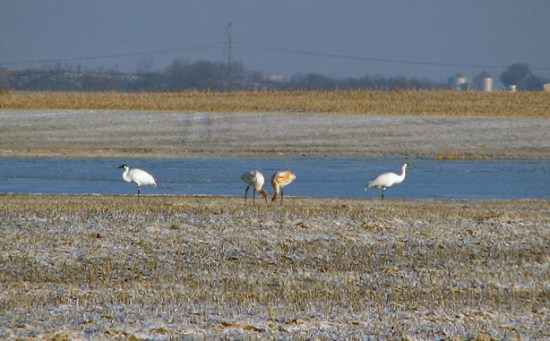
The photo shows them in Kankakee County, Illinois, on Dec. 2, 2006. Photo: Richard Urbanek
The two juveniles separated from the two adults between Illinois and Florida and joined migrating sandhills. The juveniles arrived in Lafayette County, Florida, on December 9, completing their migration to Florida in just nine days! By late December the large sandhill flock had gone, but #27-06 and #32-06 remained in the same location.
After #32-06 was killed (likely by a bobcat) at the end of January, DAR #27-06 remained alone at the same site. He was still there, alone, as of March 24.
First Spring Migration: DAR #27-06 remained alone in Lafayette County, Florida until April 21 or 22 when PTT data indicated he began migration. By April 27-28 he had reached Allen County, Indiana. He arrived in Michigan May 3 or 4 while attempting to complete migration to Wisconsin. He encountered Lake Michigan and ended up staying until he was captured and brought back to be released at Necedah NWR in Wisconsin on May 14.
Fall 2007: DAR #27-06 (with #28-06) began migration on Nov. 5 and made it all the way to Jasper-Pulaski FWA, Indiana on the first day. By Nov. 12, they arrived on the wintering area in Pasco County, Florida. They were the first Florida arrivals in the flock this winter!
Spring 2008: DAR #27-06 was still on winter territory in Pasco County, Florida on March 22, and arrived on Necedah NWR (with DAR #28-06) on April 3! DAR #27-06 broke the pair bond of #1-05 and #10-03 and was seen together with female #1-05, but she didn’t stay with #27-06. On September 27 he was seen on the refuge with #12-04 and #9-05. He has a nonfunctional transmitter and cannot be tracked.
Fall 2008: DAR #27-06 and DAR #28-06 disappeared from Necedah NWR after October 25. An unconfirmed report of two Whooping cranes in Winnebago County, Illinois on Oct. 29 may have included #27-06. On November 19 the automatic datalogger. showed them in the area of their Florida winter home (Pasco County). Migration complete! (He has a nonfunctional transmitter so cannot be tracked.)
Spring 2009: Captured for transmitter replacement (and new colored bands) on March 4 at his Pasco County wintering site. Began migration from Pasco County on March 18 with #28-06 (DAR). They were reported in Porter County, Indiana, on the night of March 22. They completed migration to Necedah NWR by March 28. He was unpaired throughout the summer and remained in the Necedah NWR area.
Fall 2009: Male DAR #27-06 began associating with Female DAR #42-07 in early October. The newly formed pair remained at Quincy Bluff in Adams County, Wisconsin, thoughout October. He was reported in Dane County, Wisconsin, from November 15-25 with #42-07* (DAR) and #24-05. They were no longer at this location on November 26 and completed their migration in Morgan County, Alabama.
Spring 2010: He left Alabama sometime after March 6 with #24-05 and #42-07 (DAR). His signal was detected March 17 at Necedah NWR in Wisconsin, but he had not yet been visually confirmed. He was among the earliest arrivals back in Wisconsin.
Fall 2010: Male #27-06 DAR and female #26-09 were found near Grundy County, Illinois, during an aerial survey on December 2. They were detected flying through western Kentucky on December 6th and reported at Wheeler NWR, Morgan County, Alabama, on December 8th.
Spring 2011: Male #27-06 DAR, still with female #26-09 (#926), was on his winter territory until at least the morning of March 2. The two were not found there on March 3, but were reported back at Necedah NWR by March 10. They were observed building a nest in May. No chicks.
Fall 2011: Crane #27-06 DAR, with his mate #26-09, migrated to Alabama’s Wheeler National Wildlife Refuge and spent the winter there.
Spring 2012: Crane #27-06 DAR and his mate #26-09 were detected arriving back at Wisconsin’s Necedah NWR on March 11, migration complete!
Fall 2012: Migrated south to Wheeler NWR, Alabama, with mate #26-09.
Spring 2013: Trackers assumed that male #27-06 DAR probably completed migration with his mate, Crane #26-09 on March 17 when her signal was detected on Necedah NWR. (Tracker Eva says the pair may have moved off the frozen ponds to a more hospitable location.) By late April or early May the pair had a nest together but it failed in early May. The pair did not attempt a second nest this summer.
Fall 2013: Migrated to Wheeler NWR in Alabama with mate #26-09.
Spring 2014: Crane pair #27-06 DAR and #26-09, along with# 3-11, #4-11, #17-11, #19-11 and #38-09 DAR began migration from the Wheeler NWR in Alabama between Feb. 15-18. This large group was reported in Gibson County, Indiana, on February 21. They then moved to Lawrence County, Illinois, by the next day and were seen with an eighth (and unknown) bird that tracker Eva believes that might be #26-10 DAR. On March 21, #27-06 DAR and #26-09 completed migration to Necedah NWR. By mid April this pair had a nest with one egg, but the nest had failed when checked April 30.
Fall 2014: Male #27-06 DAR left the Necedah area with mate #26-09 sometime after Oct. 24. They wintered again at Wheeler NWR in Alabama.
Spring 2015: Male #27-06 DAR, with mate #26-09, completed spring migration back to Necedah NWR in Wisconsin March 14 or 15! Their second nest of the season hatched one chick on June 8, but the chick did not survive the month.
Spring 2016: Pair #27-06 DAR and #26-09 returned from spring migration and nested on Necedah NWR in May and were still nesting June 7.Their new chick, W22-16, hatched on June 10 but did not survive into the summer.
Fall 2016: Male #27-06 DAR and mate #26-09 were still in Juneau County, WI as November began but migrated in December to Wheeler NWR in Morgan County, Alabama.
Spring 2017: Pair #27-06 DAR and #26-09 returned to Necedah NWR and were nesting by early April. Eggs from their first nest were collected in the forced re-nesting study but the pair did not make a second nest.
Sadly, male #27-06 was found dead by Wisconsin DNR pilot Bev Paulan on May 18, 2017.
Click here to jump to the top of this page.
Crane #28-06
Sex: Male
Hatch Date: May 29, 2006
Personality and History
Before Release – Marianne says #28-06 Is a good flyer. He seems to float between hanging out with the older chicks as well as the younger ones. He and #30-06 have had several battles for their place in the hierarchy. Now #28-06 is once again dominant over #30-06.
Chick #28-06 often hangs out with #32-06. Of all the DAR chicks, #28-06 is the lightest in coloration right now. He still is cinnamon and white but the brown is lighter than it was earlier.
Oct. 4, 2006: The DAR chicks had their pre-release health checks.
Oct. 17, 2006: Dr. Richard Urbanek said the DAR birds received their permanent leg bands. Chick #28-06 and the other four will be released as soon as they get used to their new leg bands and transmitters. Their freedom is near! Will they hang out with, and then follow, the older whooping and sandhill cranes to learn their migration route?
October 21: Chick #28-06 (with #26-06) was set free on the Wisconsin refuge where it spent its first months of life. The two newly released chicks quickly returned to the pool in their rearing area, and remained there to roost. The next day they visited with the First Family, also at home on the refuge (until fall migration).

Look who joined parents 11-02 and 17-02 with their chick on October 22. Can you find newly-released chicks DAR 26-06 and 28-06? (The chicks still have tawny feathers.) Also visiting the first family are cranes 7-03, 12-05 and 19-05. Photo: Richard Urbanek
History
On October 28, DAR chick #28-06 left Wisconsin with #26-06 on their first migration! but moving too fast for the ground tracker! PTT readings from #28-06 for Oct. 29 and 30 showed him in southern Indiana! A roost check on the night of 30 October confirmed that #26-06 and #28-06 stayed together. They were seen Oct. 31 and again Nov. 25 in Indiana, feeding mainly in harvested cornfields with hundreds of sandhill cranes. On December 4 they continued migration to Hiwassee Wildlife Refuge, in Tennessee. They left Hiwassee December 7 and were detected Dec. 8 in Florida. They are moving around a bit, but staying in areas where our Eastern flock spends the winter. They were with wintering sandhill cranes in Pasco County at the end of December. On Jan. 12 they flew to the Chass pen site for a quick visit before flying off to a lake in Hernando County.
Spring 2007: Began migration (with #26-06) from Pasco County, FL on March 24.
They flew to Thomas County, Georgia that day. They roosted in Tennessee on the nights of March 25 and 26. They were grounded by rain and poor migrating conditions in Daviess County, Indiana for the rest of the week. On April 1 the two separated. DAR #26-06 remained behind while DAR #28-06 continued migration to Pulaski County, IN. He left there on April 17. On April 19 he was detected in flight in south-central Wisconsin. April 20 he continued northwestward and roosted in Olmsted County, Minnesota. He returned to Wisconsin on April 21 and returned to Necedah NWR on April 23. He roosted that night with #7-03 and W1-06.
Fall 2007: DAR #28-06 (with #27-06) began migration on Nov. 5 and made it all the way to Jasper-Pulaski FWA, Indiana on the first day. By Nov. 12, they arrived on the wintering area in Pasco County, Florida. They were the first Florida arrivals in the flock this winter!
Spring 2008: DAR #28-06 was still on winter territory in Pasco County, Florida on March 22, and arrived on Necedah NWR (with DAR #27-06) on April 3! He wandered a great deal but on May 17 he returned to a Juneau County location where he remained with #27-06.
Fall 2008: DAR #28-06 and DAR #27-06 disappeared from Necedah NWR after October 25. He has a nonfunctional transmitter and cannot be tracked, but an unconfirmed report of two Whooping cranes in Winnebago County, Illinois on Oct. 29 may have been these two. On November 19 the automatic datalogger showed them in the area of their Pasco County, Florida winter home!
Spring 2009: Began migration from Pasco County on March 18 with #27-06 (DAR). They were reported in Porter County, Indiana, on the night of March 22. They completed migration to Necedah NWR by March 28. He associated with female DAR #42-07 on April 2 and 3. Unpaired, he was last detected by trackers on June 23, 2009.
Click here to jump to the top of this page.
Crane #32-06
Sex: Female
Hatch Date: June 16, 2006
Personality and History
Before Release
The youngest DAR chick, female #32-06 had some crooked toes when she came to Necedah. “She still has one toe we couldn’t correct,” says Marianne. “She seemed to grow very quickly and is a slender female. This chick was exercised with #30-06 and #31-06 and we called them the trio. She often will rest beside a willow tree or the chick pens or in the night pen, where she hangs out by the post. I think this is mainly for shade, but it also it gives her cover to hide from the older ones who picked on her—especially #29-06. By the end of August, #32-06 was running and flapping her wings, but she was still a week away from flying. Somehow, she has the ability to get her flock mates to fly even though she’s not top in the pecking order.
“Now that the chicks are all flying and are able to more easily get away from predators, we try to leave them in the marsh to forage on their own. This also helps them become more independent. Chick #32-06 has figured out that we are going to leave and she keeps a really close eye on us!”
Oct. 4, 2006: The DAR chicks had their pre-release health checks.
Oct. 17, 2006: Dr. Richard Urbanek said the DAR birds received their permanent leg bands. Chick #32-06 and the other four will be released as soon as they get used to their new leg bands and transmitters. Their freedom is near! Will they hang out with, and later follow, the older whooping and sandhill cranes to learn their migration route?
October 20: Chick #27-06 (with #32-06) was set free on the Wisconsin refuge where she spent her first months of life. The two newly released chicks didn’t return to the pool where they grew up, and remained at the release site to roost. They were hanging out with the older whooping cranes (#11-03 and #1-03) who are also at that site. That’s a good sign!
History

DAR #27_06, DAR #32_06 and adult pair #12-03 and #16-03. Photo: Richard Urbanek
Fall 2006: Finally began fall migration on Nov. 30 with #27-06 and adults #16-03 and #12-03. An ICF tracking intern tracked the four cranes to Illinois that night. These birds were one of the last groups to leave Necedah NWR. If they stay together, the DAR chicks will have two migration veterans to show them the way! The photo shows them in Kankakee County, Illinois, on Dec. 2, 2006.
The two juveniles separated from the two adults between Illinois and Florida and joined migrating sandhills. The juveniles arrived in Lafayette County, Florida, on December 9. By late December the large sandhill flock left, but #27-06 and #32-06 remained. The two DAR birds completed their migration to Florida in just nine days!
DAR #32-06 apparently died in Florida after being seen Jan. 18 and before she was next checked by trackers on Jan. 22. They found her remains on Feb. 6. Bobcat predation is suspected. DAR #27-06 remained in the area until April 21-22 when he began his northward migration.
Click here to jump to the top of this page.
Group Three: Wild Hatched Cranes
The first wild-hatched Whooping Crane in the Eastern Migratory Population!
Crane #W1-06
Sex: Female
Hatch Date: June 21 or 22, 2006
Fall 2006: W1-06 is a very special chick! She was the new flock’s very first wild-hatched chick to survive. She is now the first second-generation Whooping crane to successfully make the migration south. That’s really something to celebrate! W1-06 left Wisconsin on her first migration on November 19 with her parents. The family arrived at the Florida wintering grounds Dec. 9. Their first stop was where the parents first migrated when they were chicks: the winter pen at Chassahowitzka National Wildlife Refuge (“Chass”). To the surprise and concern of experts, they stayed a while in a neighborhood in Hernando County, Florida. They were seen in backyards only a few meters from houses, eating under bird feeders and in flower beds. This is not a good choice of habitat, so experts are keeping an eye on the family.
Trackers confirmed that the first family survived the Florida storms of Feb. 1-2 that killed 17 of the 2006 ultralight flock. W1-06 is the only other remaining wild whooping crane hatched in 2006 to the new Eastern Flock.
Spring 2007: The First Family (Mom #17-02, Dad #11-02, and female chick W1-06) began the young crane’s first northward migration from Florida on Feb. 23. No further reports were received until March 20 — when the First Family arrived back at the Necedah National Wildlife Refuge! Whooping Crane #W1-06 is the first wild-hatched chick in the eastern migratory population and the first to complete a round-trip migration by following her parents.
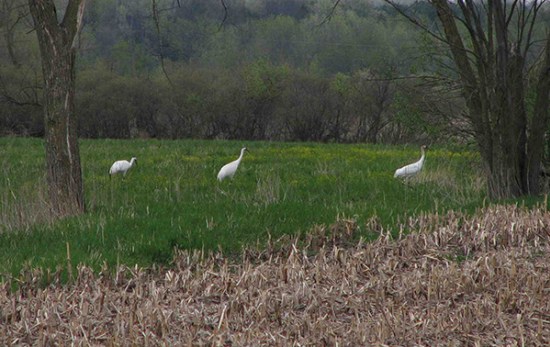
May 4, 2007. Photo: Richard Urbanek
An aerial survey on March 23 showed that #W1-06 had now separated from her parents, and she was seen roosting alone that night on the refuge, near but not on her parents’ territory. Hooray! This is normal behavior for a chick her age. In her first independent days, she spent time with other whoopers. Here she is with #10-05 and #11-05.
Fall 2007: W1-06 began migration from Wisconsin on Nov. 21 along with #11-05, #14-05, #7-03, #2-04, and #12-04. She safely arrived in Florida with adults #11-05 and #14-05 on December 2! Apparently she was leading the way during the final flight into FL because all three landed at the lake where #W1-06 spent her first winter with her parents. The next day the two males left but #W1-06 stayed, often foraging by herself or with a few sandhill cranes. Then, a few weeks later, see who arrived:
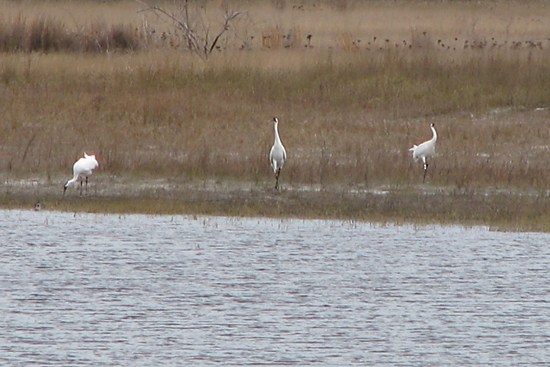
Juvenile #W1-06 was on her parents’ winter territory when they arrived on January 4, 2008. ICF tracker Eva watched the family reunion. Photo Eva Szyszkoski, ICF Tracking Team
All 3 whooping cranes were less than 1 meter apart then #W1-06 started walking away. The parents caught up with her and all 3 continued walking. Then stopped and foraged together. It will be interesting to see what happens next. Chasing the youngster away would be expected behavior, but they spent most of the winter with their juvenile. The parents migrated very early from Florida, leaving #W1-06 to migrate by herself! (She was successful!)
Spring 2008: She began her second journey north on March 9 and was tracked to Thomas County, Georgia. Confirmed back at Necedah on March 30!
In early April, Sara Zimorski said, “We were excited to see #W1-06 and #7-03 hanging out together and hope they may become a pair.”
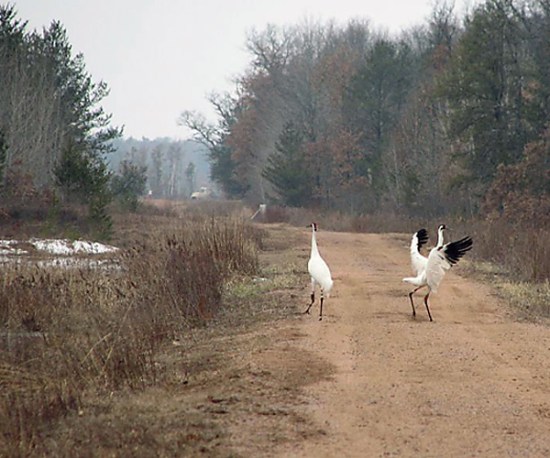
Male #7-03 trying to dance with #W1-06. But soon she had another boyfriend: #10-03. Photo Sara Zimorski
But in April, #W1-06 joined up with #10-03. Eva said, “They actually built a nest and she was observed sitting on it!! They were not on it the next day, and there were no eggs (#W1-06 is too young), but it’s exciting news anyway!”
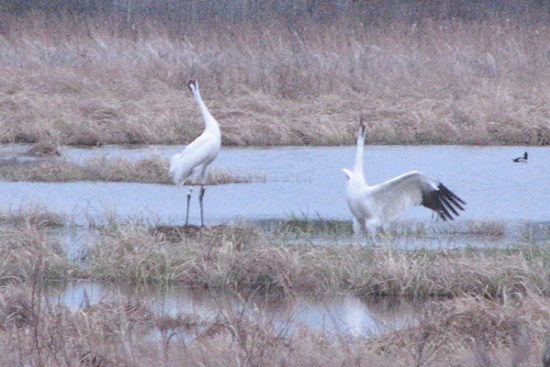
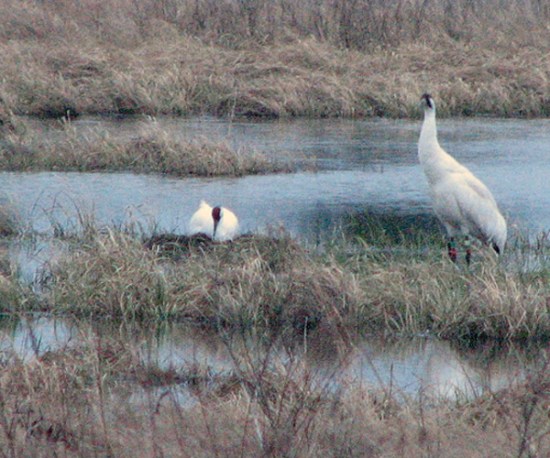
April 9: First nest of wild-born female W1-06! No eggs, but good practice! Male #10-03 is with her. Photos: Richard Urbanek, ICF
Tracker Anna Fasoli said, “W1-06 has apparently found a new love with #10-03, possibly filling the void that his stolen mate left? They even built a nest together, and sat on it for a day (no egg: #W1-06 is too young). The new pair is still together. They defend their new territory from any crane that enters it. They frequent a few corn fields off the refuge, but always return to the refuge. Male #7-03 is usually not far away, lurking in the shadows of their territory, possibly plotting to steal her back. Regardless, #W1-06 seems to have MANY different options for mates, although it looks as though she has found “the one” in #10-03, as building a nest together signifies a strong bond.”
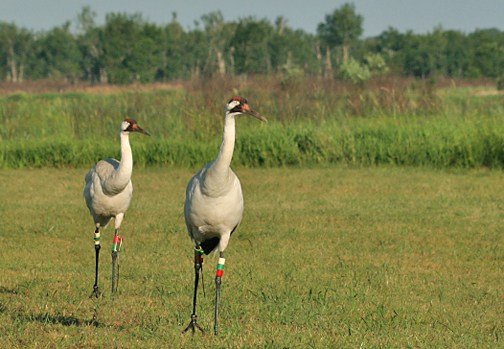
August 2008: Wild female #W1-06 and ultralight-led male #10-03 are a pair. Photo: Operation Migration
By August, she was still with male #10-03. They liked to hang around the grassy training strip where the Class of 2008 chicks were learning to fly with the ultralight.
Fall 2008: Began migration from Wisconsin on November 17, along with mate #10-03 and 12 other Whooping cranes. They were detected in flight while migrating over Perry County, Indiana, on December 7. The pair arrived on #10-03’s previous wintering area in Colleton County, South Carolina, on December 17.
Spring 2009: #W1-06 and mate #10-03 left their South Carolina winter territory during March 11-16. They were reported in Fountain County, Indiana, March 18-21. They completed migration to Necedah NWR in Wisconsin March 23. Sara Zimorski reports, “Apparently #7-03 has been trying (and may have succeeded) to steal #W1-06 away from #10-03. Last year #7-03 and #W1-06 were hanging out together before #10-03 came along so we’ll see what happens.” In April #10-03 and #W1-06 built a nest but it was unsuccessful. She and her mate stayed in the core area all summer.
Fall 2009: Female #W1-06 and her mate #10-03 began migration November 26 along with several other whoopers. These two were located at a previously used stopover on a reclaimed surface mine in Indiana, on November 28 for an extended stay. They were confirmed on their wintering territory in Colleton County, on January 5.
Spring 2010: Pair #W1-06 and #10-03 were no longer detected on their wintering area after March 1. Male #10-03 was reported back on Necedah NWR on March 22, and #W1-06 (later confirmed on March 28) presumably arrived with him. They were observed on a nest during an aerial survey on April 5, but the nest was unproductive.
Fall 2010: #W1-06 got her transmitter replaced by ICF’s Marianne Wellington, Richard Urbanek and Eva Szyszkoski before fall migration:
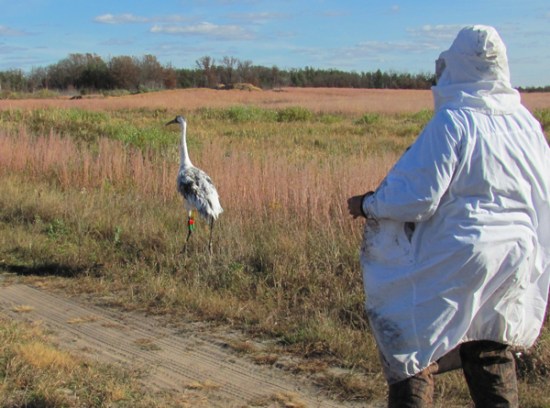
W1-06 walks away with a new band—and lots of mud on her feathers!
Fall 2010: Female #W1-06 and male #10-03 began migration on November 20. They were found east of Terre Haute, Indiana on November 24 and stayed there at least through December 11. They were next reported on their usual wintering territory in Colleton County, South Carolina, on January 5.
Spring 2011: Last detected in Colleton County SC on Feb. 19, migrating pair #10-03 and #W1-06 was in Parke County, IN at least through March 16. They completed migration to their territory on Necedah NWR, by March 25. By April 8 the pair was incubating on a nest, and on May 9 came the thrilling news of a chick! Female #W1-06 was the first wild migratory Whooping crane chick to be hatched in the U.S. in more than a century, and she has now produced offspring five years later! That’s something to celebrate! Sadly, the chick went missing after a few days and may have been taken by a predator. The pair did not attempt a second nest this summer.
Fall 2011: #W1-06 and #10-03 wintered in Clay and Vigo Counties, Indiana.
Spring 2012: ICF tracker Eva heard the signal of #W1-06 in flight over ICF in Baraboo, Wisconsin on March 15, but she did not hear the signal of #10-03. She was concerned, especially when #W1-06 was seen on Necedah NWR in active flight with another female. But her mate showed up on March 16, and it was a mystery where he had been. The pair had a nest together as of April 14! On the April 26 survey flight, they were off the nest and it appeared from photos that the nest was empty and had failed. They did not re-nest, so there were no chicks for this pair in summer 2012.
Fall 2012: ICF tracker Eva detected #W1-06 and Crane #10-03 at a migration stopover location in Vigo Co, Indiana on November 1.
Spring 2013: #W1-06 and mate #10-03 completed spring migration March 30. By late April or early May they were reported nesting but the nest soon failed and they did not attempt another nest this summer.
Fall 2013: ICF tracker Eva reported that two cranes, very likely #W1-06 and #10-03, were reported in Clay County, Indiana on November 16. They continued migration next from Vigo County, Indiana to Meigs County, Tennessee by January 1 and arrived at a previous wintering location in Colleton County, South Carolina soon after.
Spring 2014: Pair #W1-06 and #10-03 were seen on their wintering territory in Colleton County, South Carolina, on 21 February and had migrated back to Necedah NWR by March 31. However, everything changed after the return. Female #W1-06 paired with a new mate, #1-10 , while her former mate (#10-03) paired with #34-09 (#1-10’s former mate). The new pair nested, and the nest was still active when checked on April 30. They hatched a chick but the status was uncertain as of the May 29 aerial survey flight, as neither parents nor chick could be found. Neither adult has a working radio transmitter.
Fall 2014: Crane #W1-06 migrated south to Hopkins County, Kentucky, where she was associating with #1-10 and several other Whooping Cranes at the end of December. Those cranes were all still there in February, 2015.
Spring 2015: Crane #W1-06 and mate #1-10 were seen back on Wisconsin territory during the March 25 aerial survey by Bev Paulan, DNR pilot. The pair nested, but the nest failed April 30, and they did not re-nest.
Spring 2016: Crane #W1-06 and mate #1-10 migrated back to their Wisconsin territory and were seen on a nest during the May 19 and June 3 aerial surveys by Bev Paulan, DNR pilot. Their new chicks, #W16-16 and #W17-16, were first seen on June 2 and June 5 respectively, but neither chick survived into the summer.
Fall 2016: Pair #W1-06 and male #1-10 were still in Juneau County, WI as of Nov. 25 but by early December had migrated to Greene County, Indiana for the winter.
Spring 2017: Pair #W1-06 and male #1-10 were back in Wisconsin and nesting by early April. The pair re-nested and were incubating their second nest when seen on Bev Paulan’s May 12 flight. Great news! Their chick number W11-17 hatched and as of July 11th flight was 38 days old. Sadly, refuge staff collected the remains of this crane chick on July 16th.
Fall 2017: W1-06 and 1-10 migrated to their usual winter spot at Goose Pond, Indiana in early November.
Spring 2018: The pair migrated back to Necedah Wildlife Refuge in mid-March and nested. Unfortunately, their nest was abandoned in the late April snowstorms. They did not renest.
Fall 2018: In early November, W1-06 and 1-10 were spotted at their usual wintering grounds at Goose Pond Fish and Wildlife Area in Indiana.
Spring 2019: Trackers confirmed 1-10 and W1-06 had returned to their territory at Necedah NWR by early April.
W1-06 and 1-10 were first seen nesting on April 8. The eggs from their first nest were removed for the forced renesting program.
The pair renested in late May, but the nest failed after just a few days. Unfortunately, there will be no chicks for W1-06 and 1-10 this year.
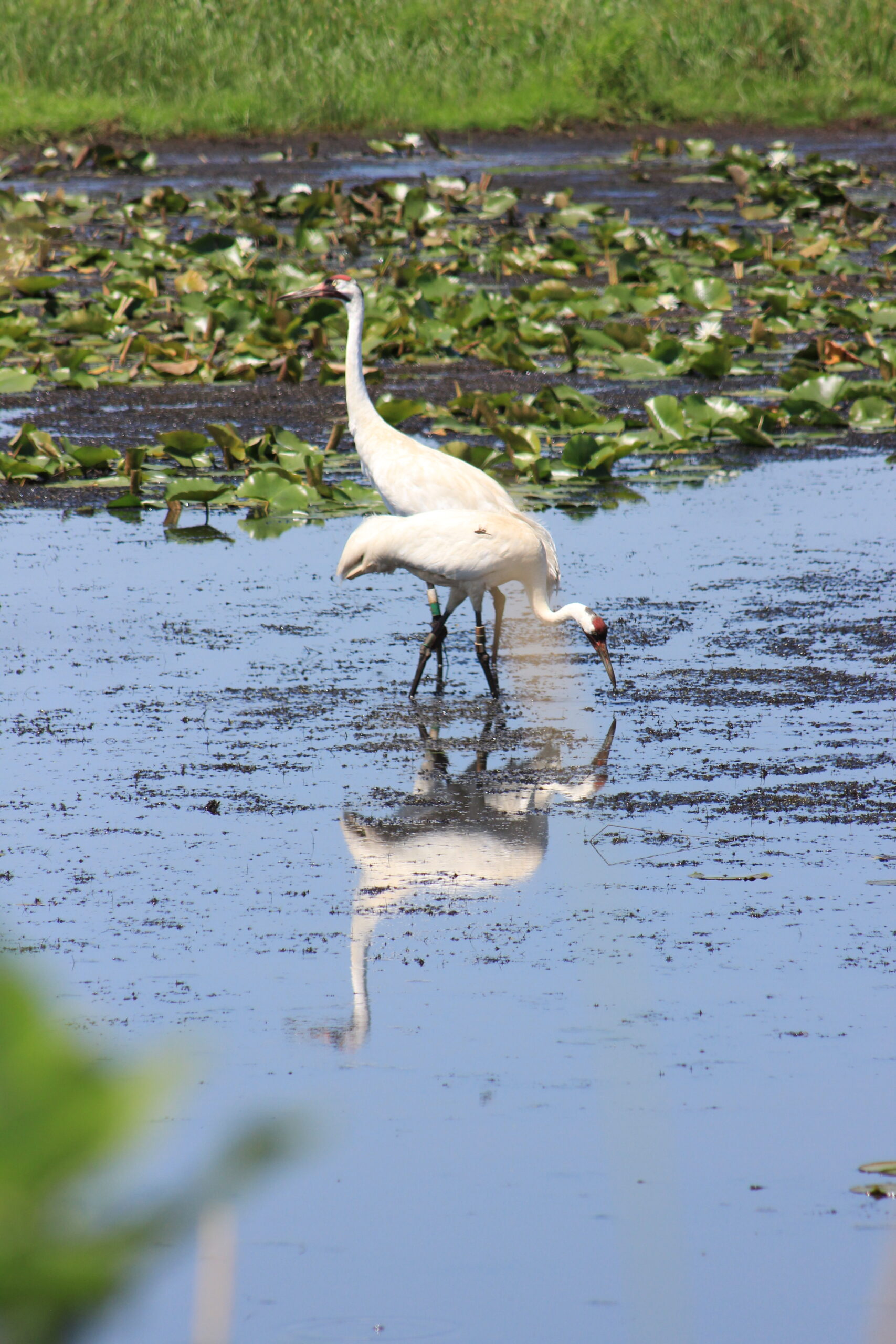
Photo: Hillary Thompson
Fall 2019: 1-10 and W1-06 were first seen at Goose Pond mid-November with a group of 8 whooping cranes. They stayed with a large group until they got back to their Spring territory.
Spring 2020: In late March, they were seen back on their territory at Necedah National Wildlife Refuge. They had a failed nest in April and then re-nested in June, hatching on chick, W17-20.
Fall 2020: W1-06 and 1-10’s chick was not seen at the beginning of July and 1-10 was found dead that same week. W1-06 was alone and started hanging out with lone male W6-18 but decided she liked male W5-18 better. W1-06 and W5-18 left Necedah NWR together at the end of October and went to Goose Pond FWA, Indiana. They have still been associating together along with a large group of young whooping cranes and breeding pairs. We hope they will nest in spring and be the first breeding pair who were both hatched in the wild!
Spring 2021: W1-06 has been associating with W5-18 since migration last year. They returned to Wisconsin from Goose Pond FWA, Indiana, in mid-March. The two have a territory at Necedah National Wildlife Refuge, and were seen copulating this spring, but they did not nest this year.
Fall 2021: This summer W1-06 was captured and fitted with a new satellite transmitter so we can track her and her mate W5-18. The pair spent three days migrating down to their wintering grounds in Greene County, Indiana. Once they made it to Greene County, they began associating with a large flock of whooping cranes that are also wintering in the area.
Spring 2022: W1-06 left her wintering grounds with a few other whooping cranes, including her mate W5-18 and male W10-15. Soon after arriving at her breeding grounds in Necedah National Wildlife Refuge, W1-06 was not seen with W5-18 and was instead associating with W10-15! The new pair began nesting in early April, however, the egg from this nest was collected as part of the forced renesting program, which helps the pair avoid black flies and nest again when black flies are gone. This egg was sent to a captive rearing facility in Louisiana and will be costume-reared for release back into the wild. This is the second instance ever in the EMP that two wild-hatch birds have nested together, the other instance (W10-18 and W6-18) was also this year! The pair began incubating their second nest in late May, and successfully hatched a chick in June! This was the first ever chick hatched by two wild-hatched parents in the EMP! Unfortunately, the chick died soon after hatching, but we are hopeful that this pair will try again next year!
Fall 2022: W1-06 and mate W10-15 spent the summer on their territory at Necedah NWR and migrated mid-October to their wintering grounds in Greene County, IN. They have been hanging out with a big group of Whooping Cranes in Indiana, which is always fun to see!
Spring 2023: W1-06 and W10-15 were one of the last pairs to leave Greene County, IN, and start their migration north. They returned to Necedah National Wildlife Refuge and started nesting in mid-April. In May, our team of biologists deployed a nest camera to monitor this nest, and there was only one egg in the nest. The pair incubated their egg diligently, despite some irritation from black flies, and hatched a chick at the beginning of June. Sadly, this chick only survived a few days, but we are encouraged by the determination of this pair!
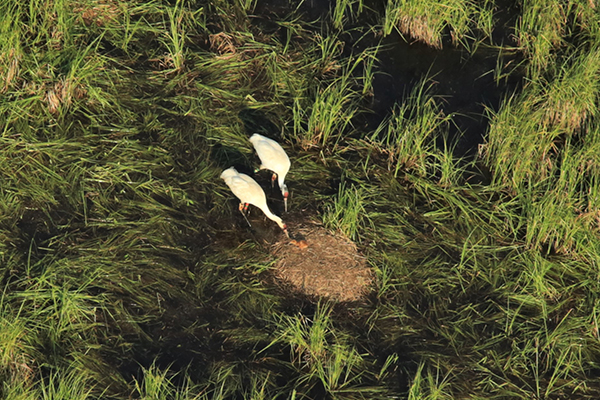
Fall 2023: W1-06 remained with W10-15 on their territory at Necedah NWR through the summer and early fall, however, W10-15 was last confirmed in June and is now considered long-term missing. Thankfully, W1-06 was able to successfully make it to her usual wintering grounds in Greene County, Indiana this season! She is not alone in this journey, as many other Whooping Cranes have wintered in Indiana in the past, and she has been seen associating with W18-20. They made it to Indiana in early November and remained until mid-January before they flew down to Alabama! After their short vacation exploring Alabama and foraging among some wintering Whooping Cranes there, the two decided to head back up to Indiana where we see them today. We hope they enjoyed their journey down south and wish them luck on the remainder of their migration!
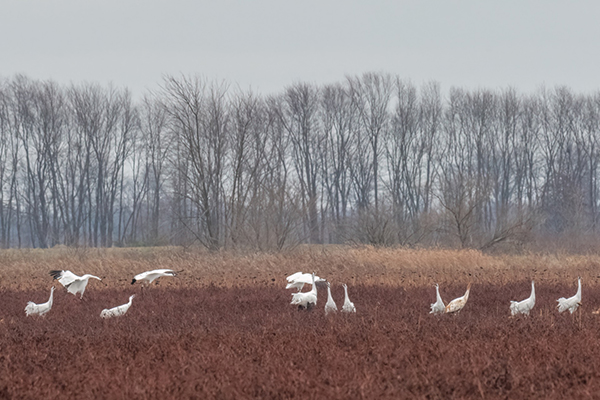
Click here to jump to the top of this page.

